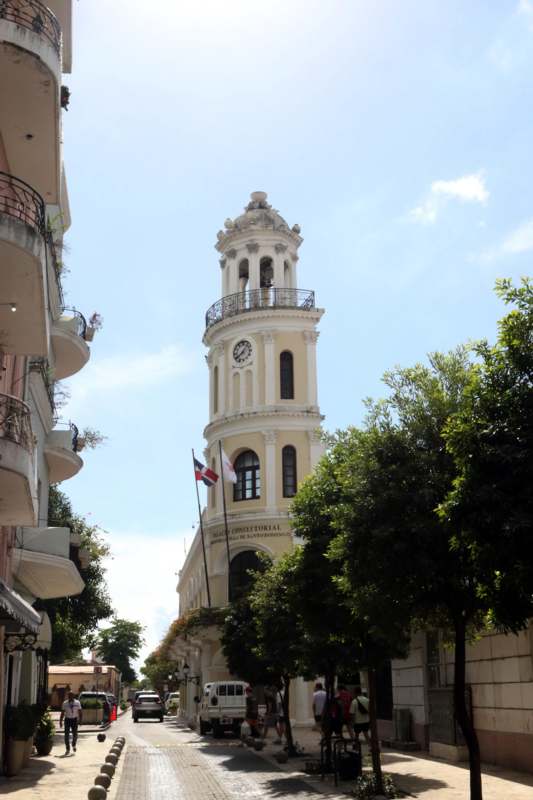
Originally constructed between 1502-04, the Consistorial Palace is another historical monument in Santo Domingo, located on Calle el Conde.
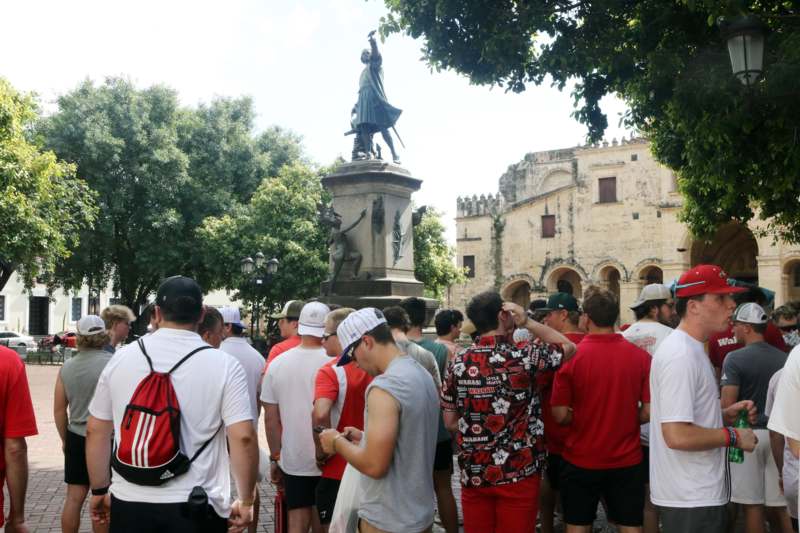
The Little Giants arrive at Parque Colon, which honors Christopher Columbus.
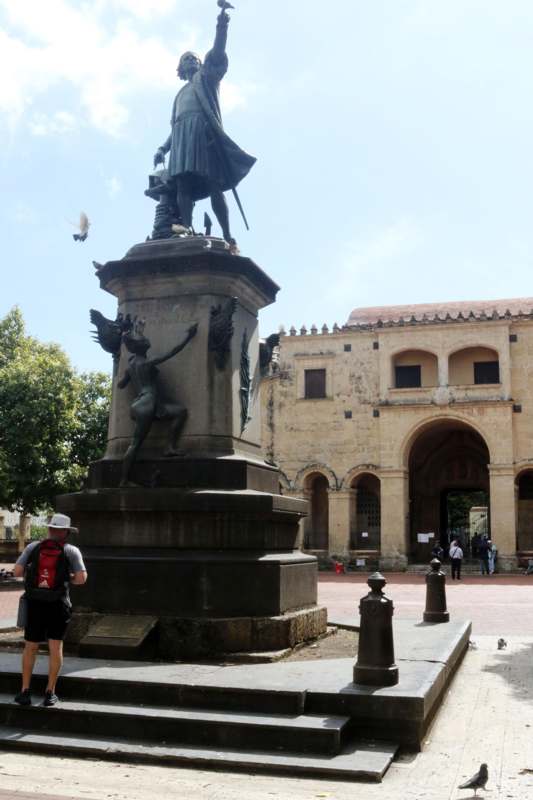
Coach Martin pauses to read the inscription at the base of the Columbus statue. In the background, Nuestra Senora de la Encarnacion, the oldest church in North America, is visible.
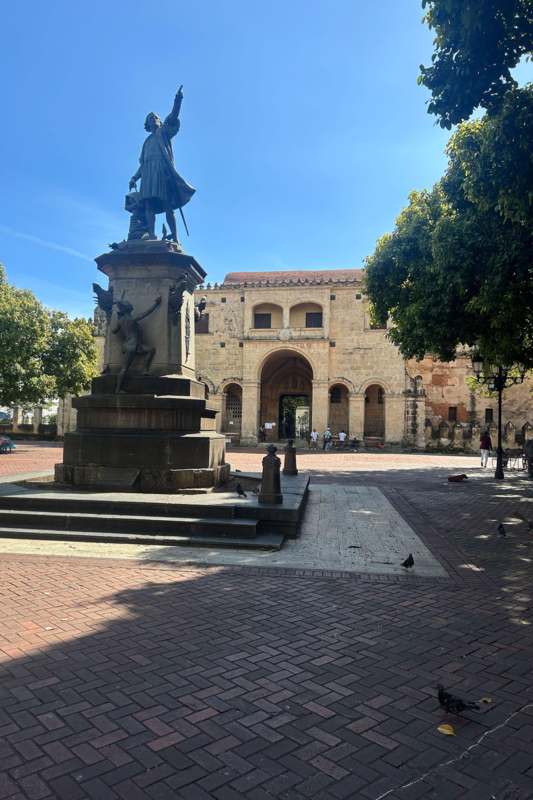
A more complete look at Parque Colon and the Nuestra Senora de la Encarnacion.
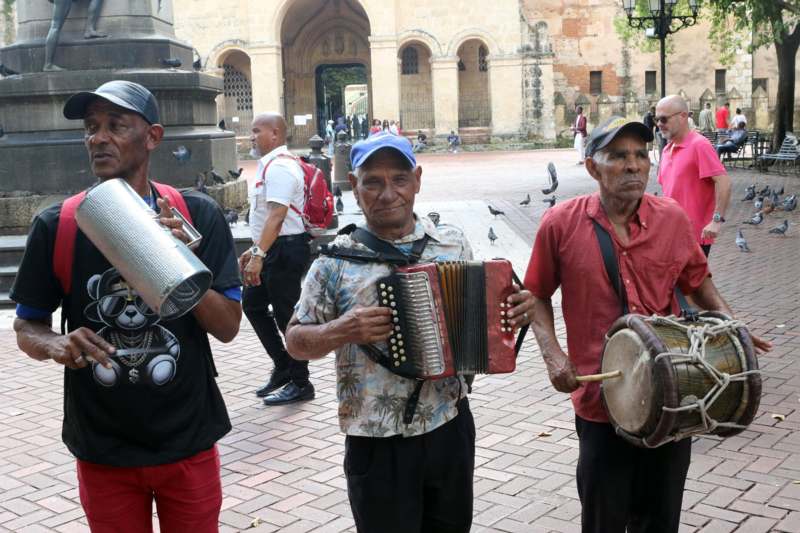
Beyond the street musicians in Parque Colon, it's worth noting that the Nuestra Senora de la Encarnacion was the site of Columbus’ final resting place until 1992.
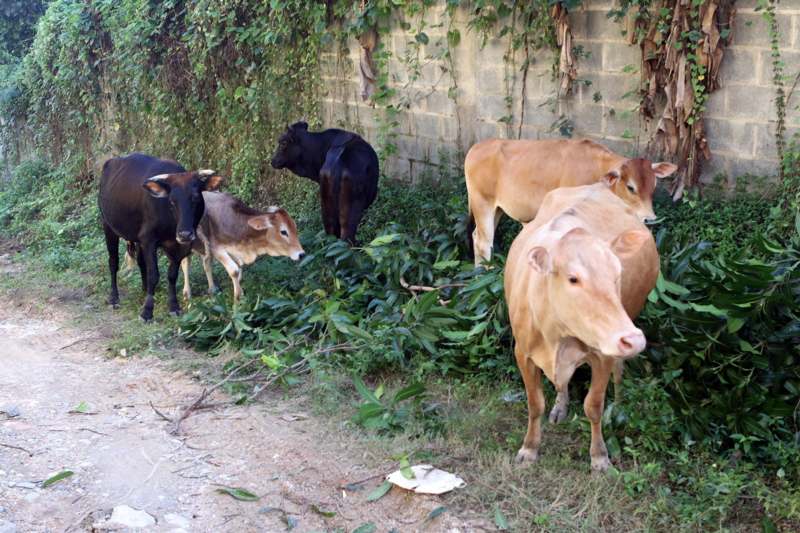
The afternoon saw the group head to a sugar mill in San Gregorio de Nigua that dates back to the early 1600s. The last few steps included these grazing neighbors.

This sugar mill is a well preserved example of early North American sugar cane processing operations.
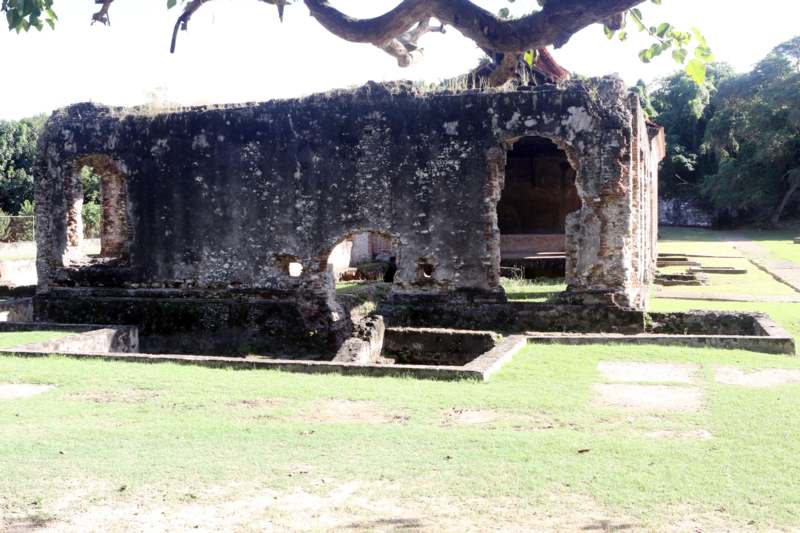
Many of the buildings in the complex are standing and largely intact.
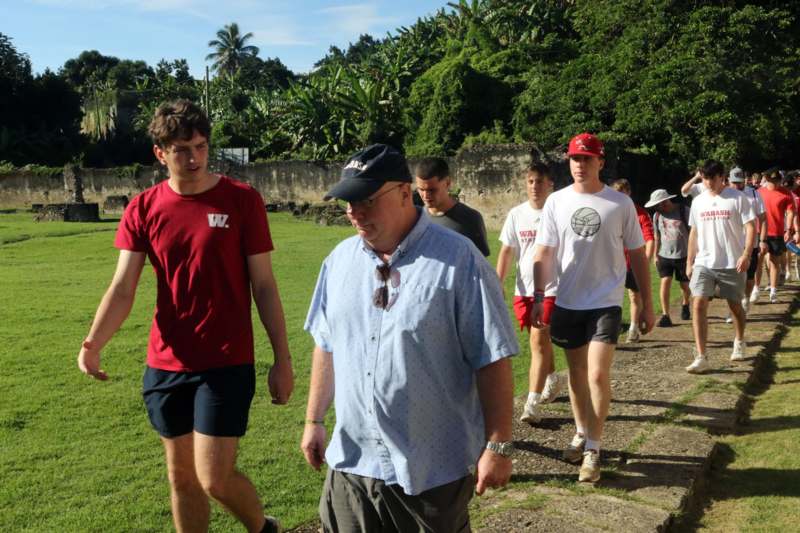
The visit to the sugar mill brought many of the students back to specific topics from their SPA 312/HSP277 course, The Dominican Republic and Baseball, this fall.
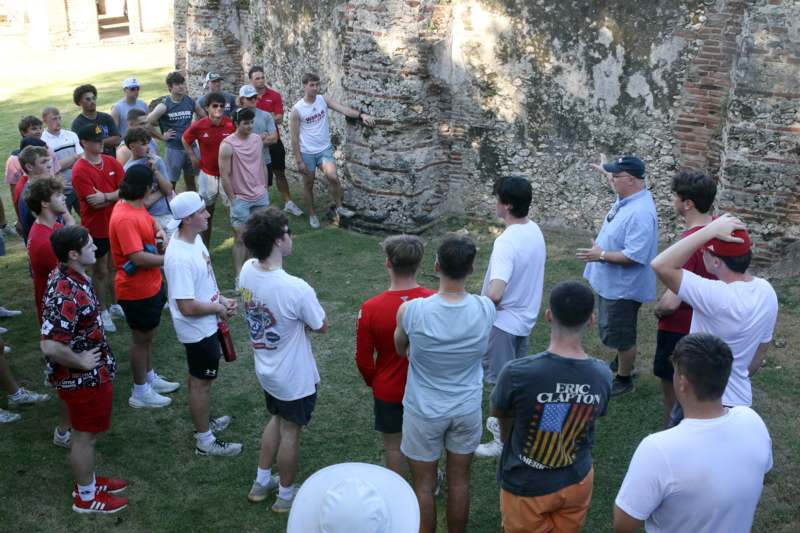
Rogers (right in blue hat) addresses the students and begins an educational discussion on site.

As Rogers said, “It's one thing to learn it in the classroom, to be interested and even excited about something in the classroom, but when you're here, when you're actually in the place that you’re studying, the connections become much more complex and filled out. Students retain them in ways they wouldn’t if they just had the class or just took a trip.”
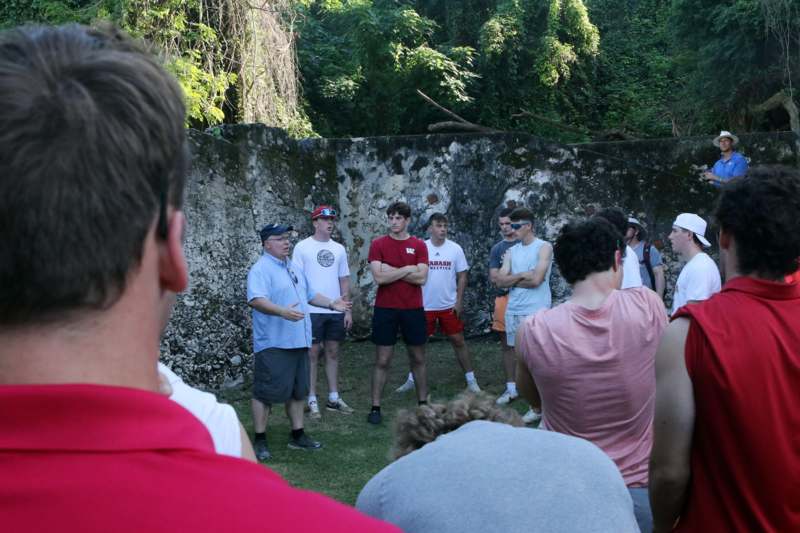
Jackson Woehr (rear center, in red shirt), was one of the students who took the trip. He made a brief presentation and facilitated a discussion about the location's history and the economic impacts.
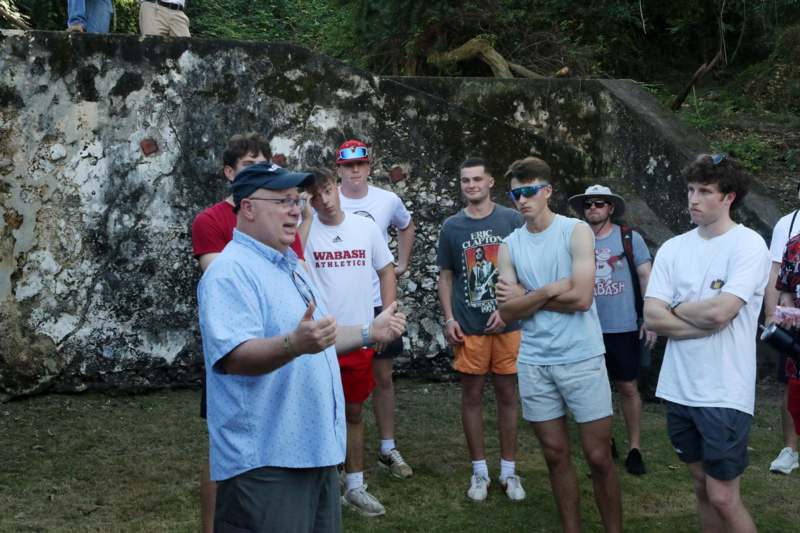
Prof. Rogers used baseball as a hook to get students to think about issues of colonialism through the Spanish colonial legacy in the Caribbean and Latin America, as well as the U.S. legacy of involvement and imperialism.
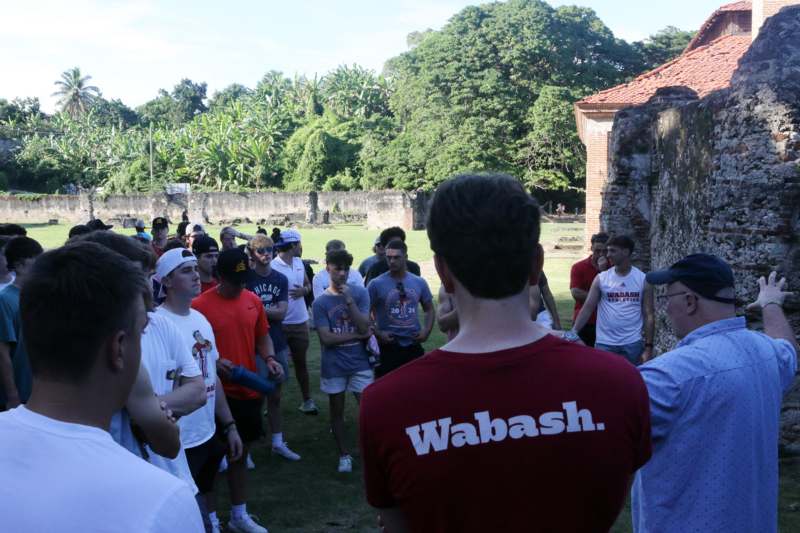
As the class learned, and shared that information with the rest of the team, sugar was king in the Caribbean in the 16 and 1700s, creating an economic engine that created wealth on the island for both Haiti, ruled by the French, and the Dominican Republic ruled by Spain. Exports like molasses and rum brought untold riches to both crowns.
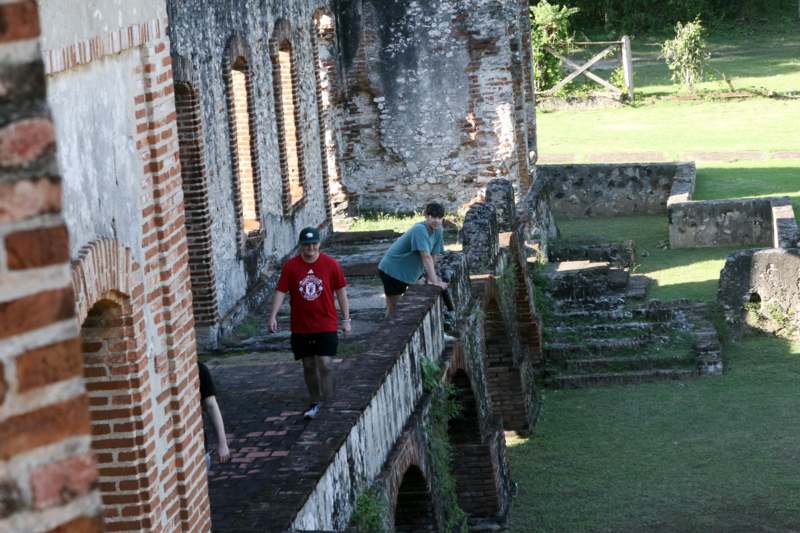
Matthew Manzuk (left) and Jacob Edwards take in the grounds.
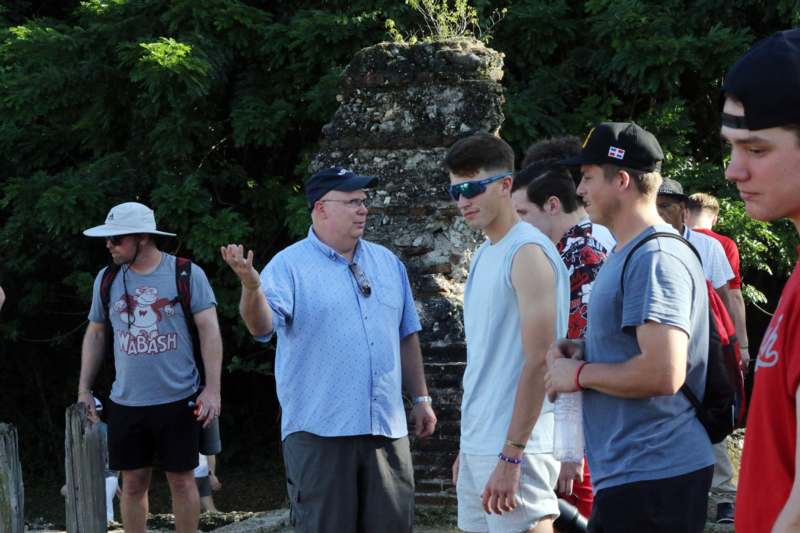
Here, Rogers (center) answers a question as Martin surveys in the background (left).
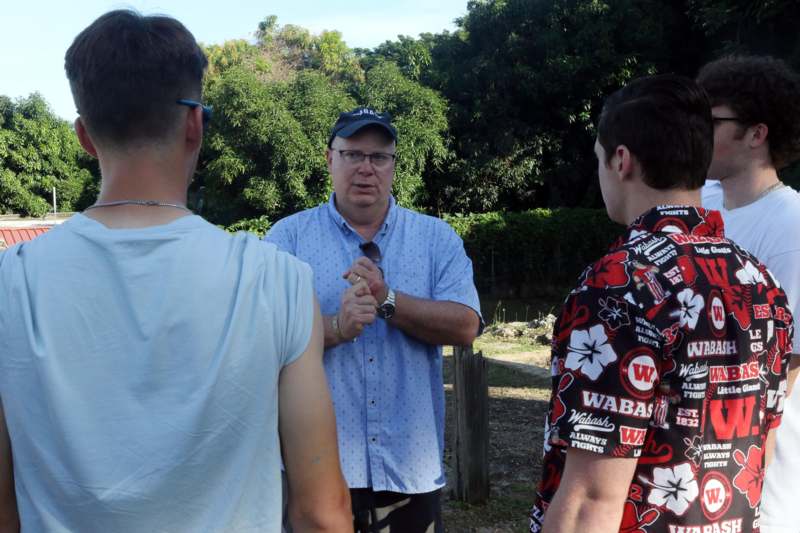
Immersion trips give professors time to explain the nuance of a subject on site.
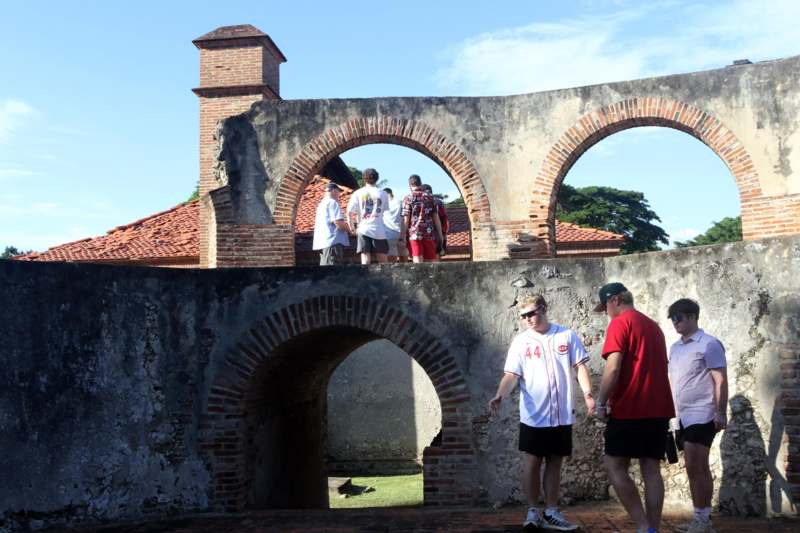
Sugar cane was processed. On the upper level, the stalks were laid out on a huge circular stone platform with a slight slope. Large stones were rolled over the stalks pressing out the sucrose, where it was collected on the lower level, where (from left) Matthew Wright, Matthew Manzuk, and Tanner Turnpaugh assess the stonework.
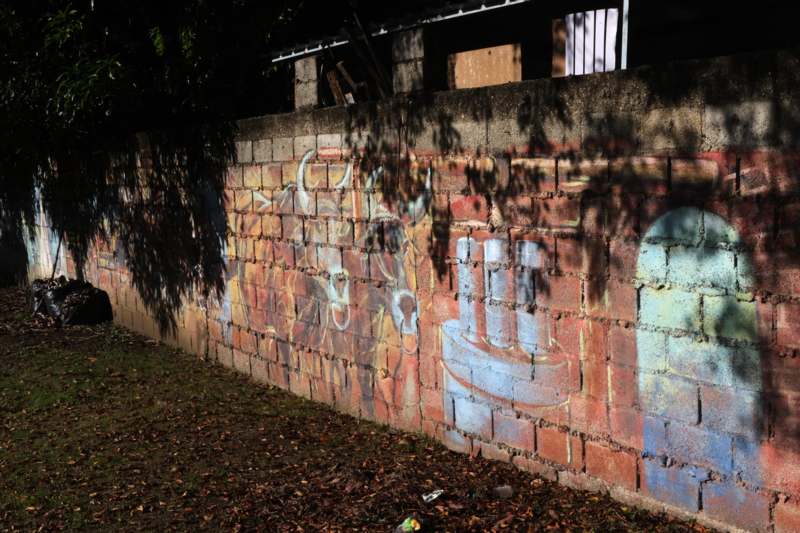
This site was also the location of the first slave uprising in the New World on Dec. 25, 1521. This mural tells that story.
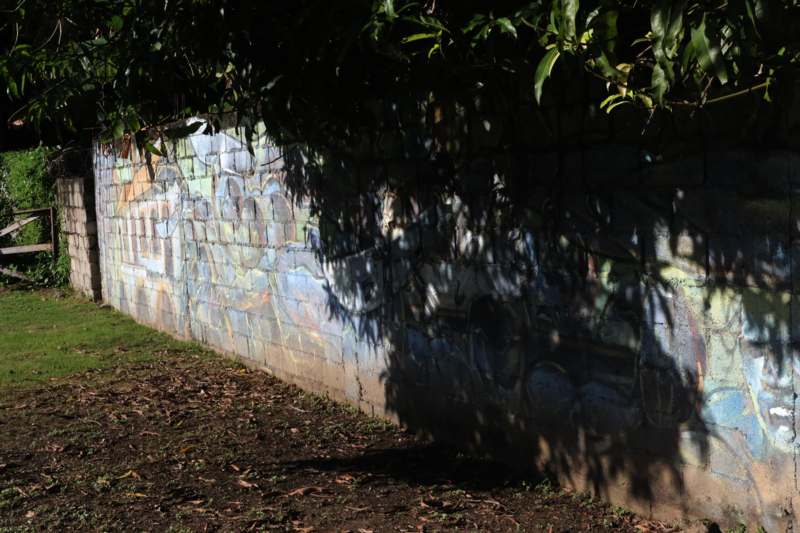
The rebellion occurred at night along the Nigua River and was eventually put down by the colonial militia.

The uprising led to new slave laws, which were issued by the colonial government of Hispaniola in January 1522.
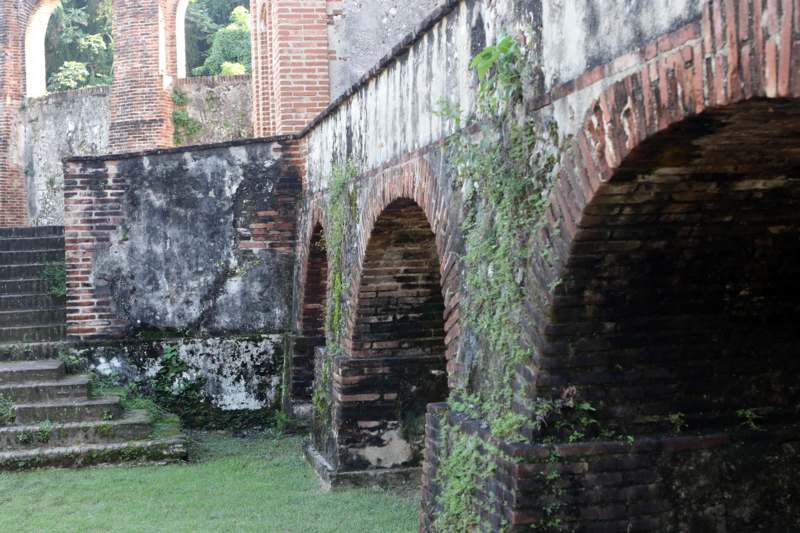
Many of the buildings feature intricate stone work of which the bricks were made on location.
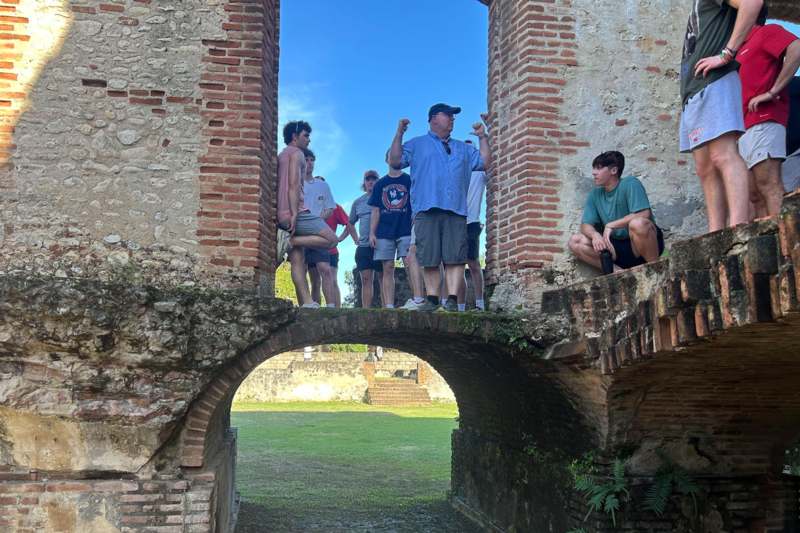
Rogers makes a point to a large group of students.

This was a great learning experience for all involved.
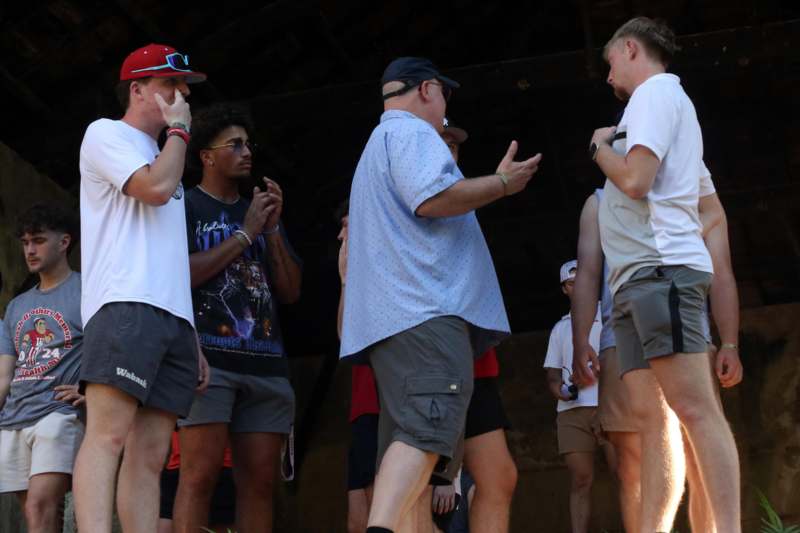
The students had plenty of questions and Rogers answered them all. Pictured here are (from left) Trey Pitcock, Miles Williams, Rhys Anderson, Prof. Rogers, and Jarrod Kirsch.
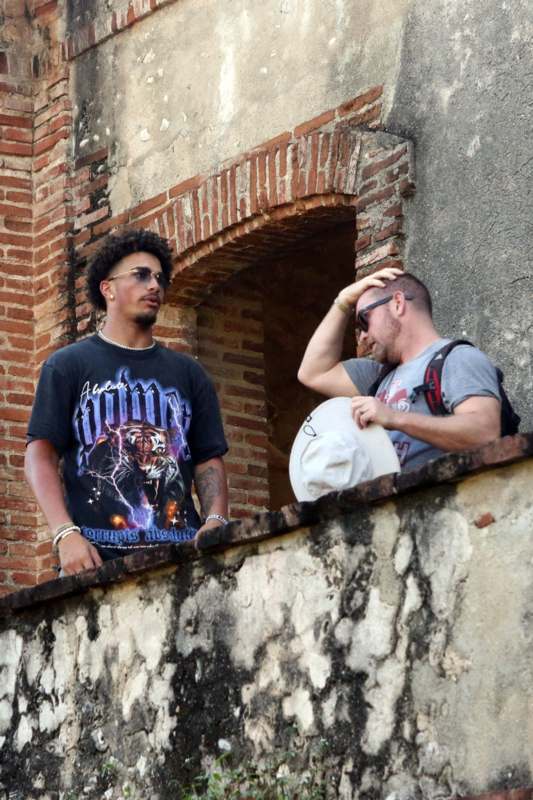
Williams (left) and Martin talk on a balcony overlook.
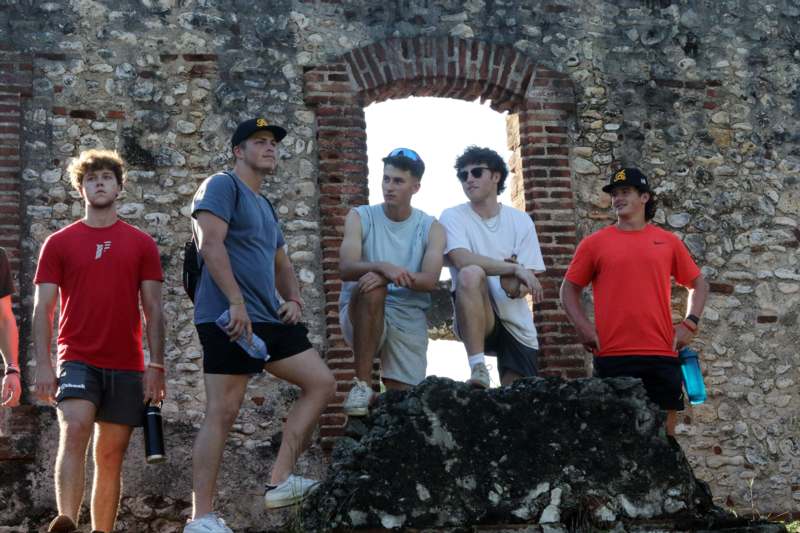
(from left) Connor Lambert, Evan Neukam, McConnell, Coby Stephens, and Henry Birk contemplate the mill's history.
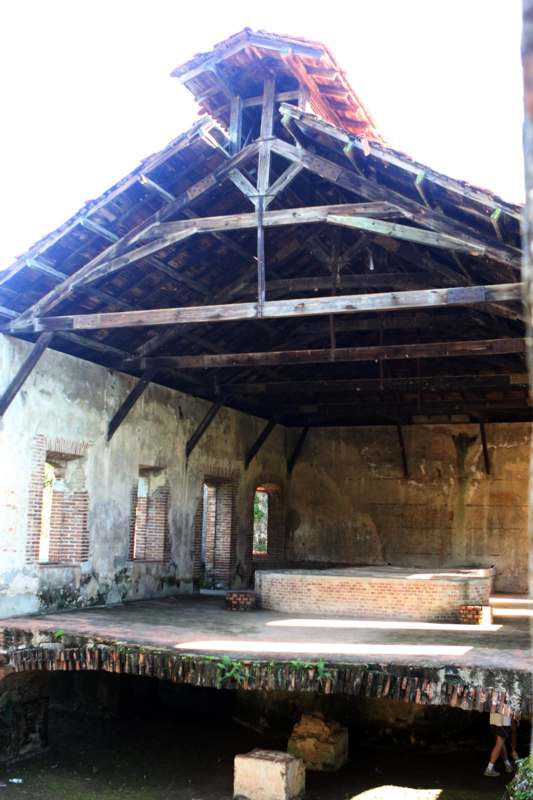
San Gregorio de Nigua provides plenty of information to assess and immerse.
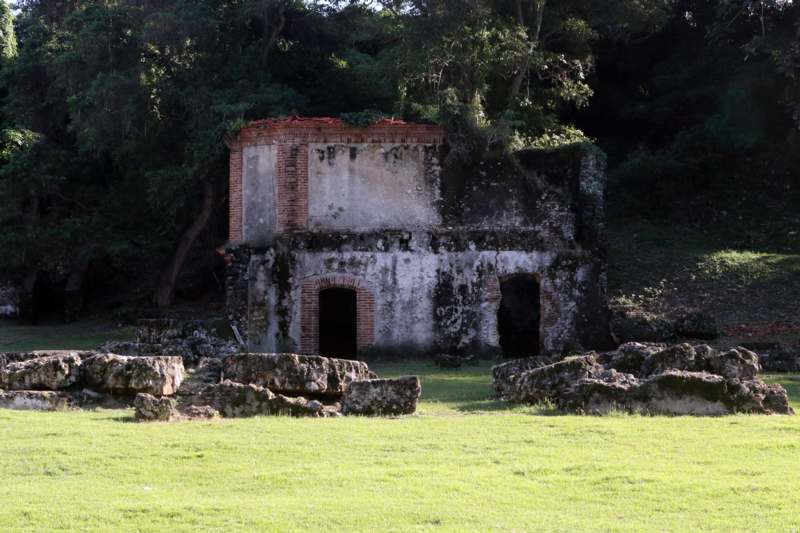
A photo of some of what remains on the property.
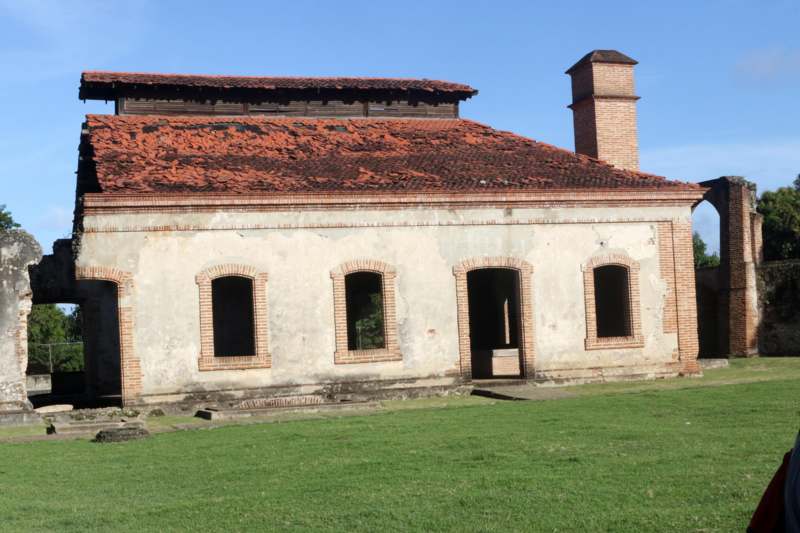
This is the main building of the complex with a still complete chimney.
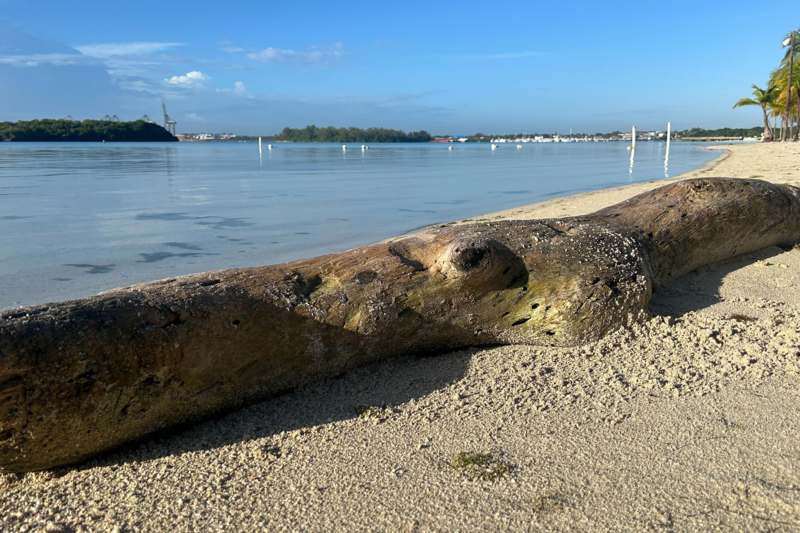
A view from the beach of the team's hotel in Boca Chica.
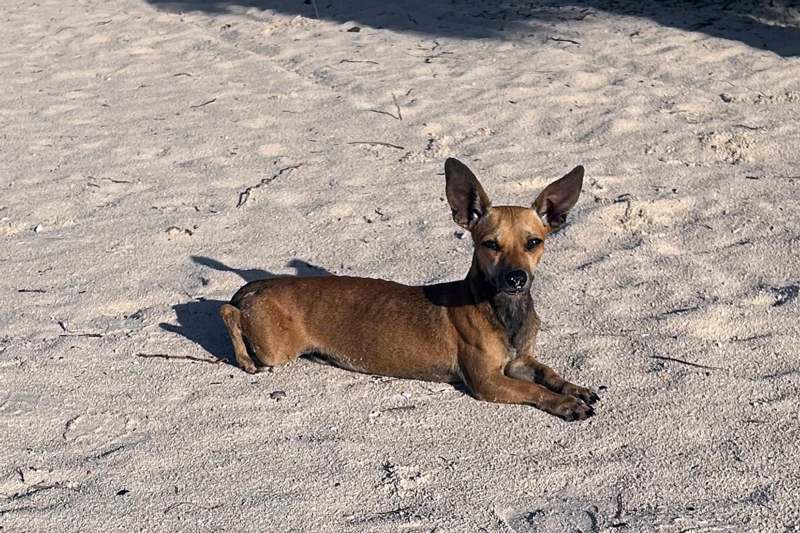
This beach dog enjoyed the morning sun.

The palm trees provided much-appreciated shade.
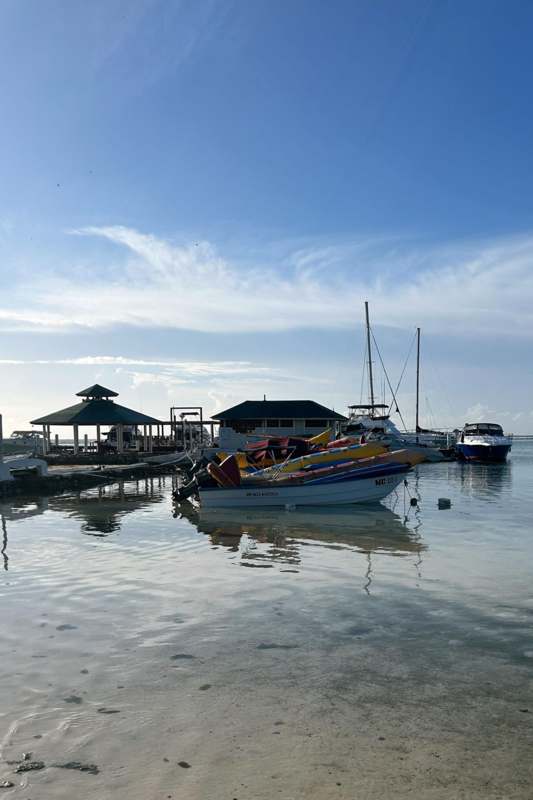
Boats anchored near by.
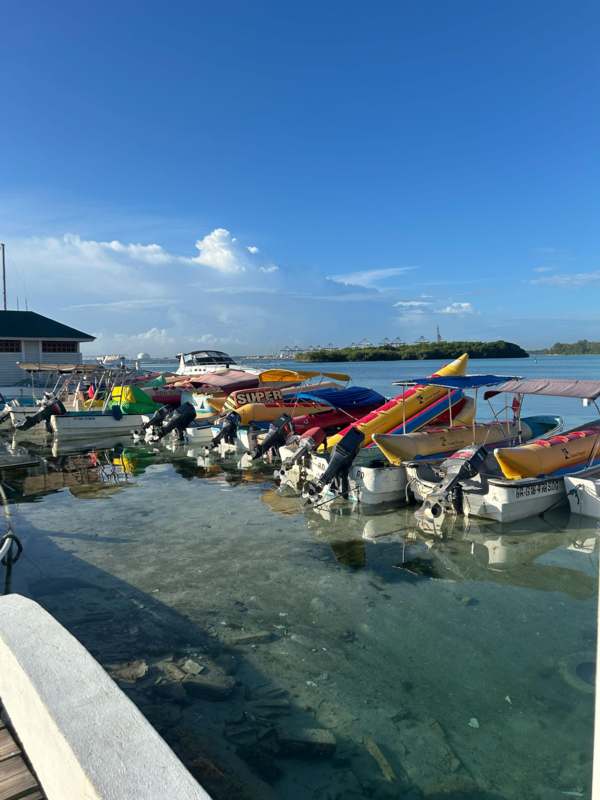
These boats provide plenty of activity on the water.
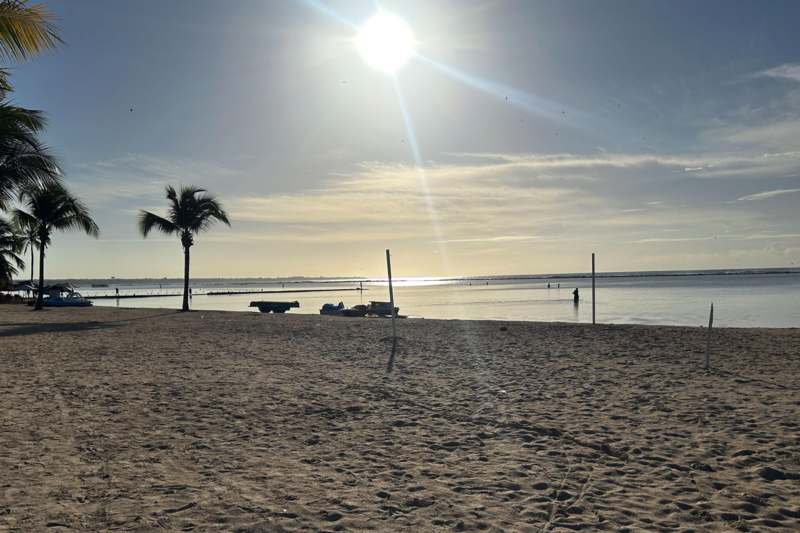
The sunrise on Dec. 19.
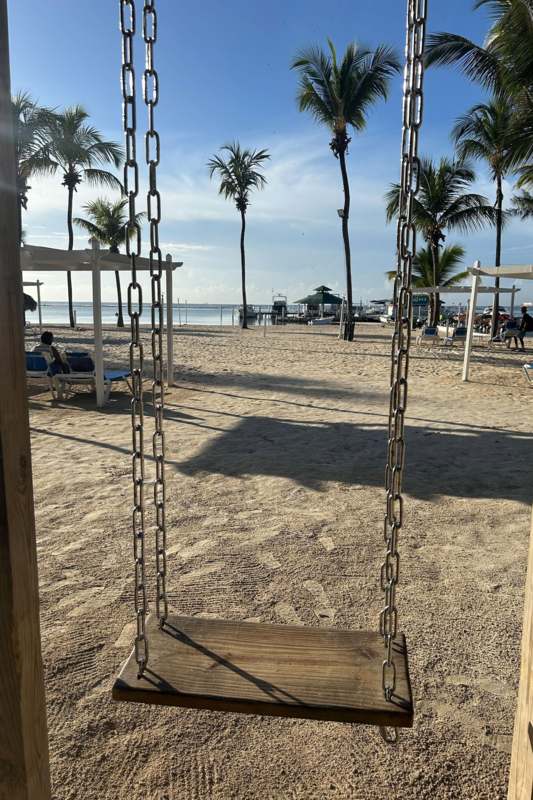
This swing could be a nice beach diversion.
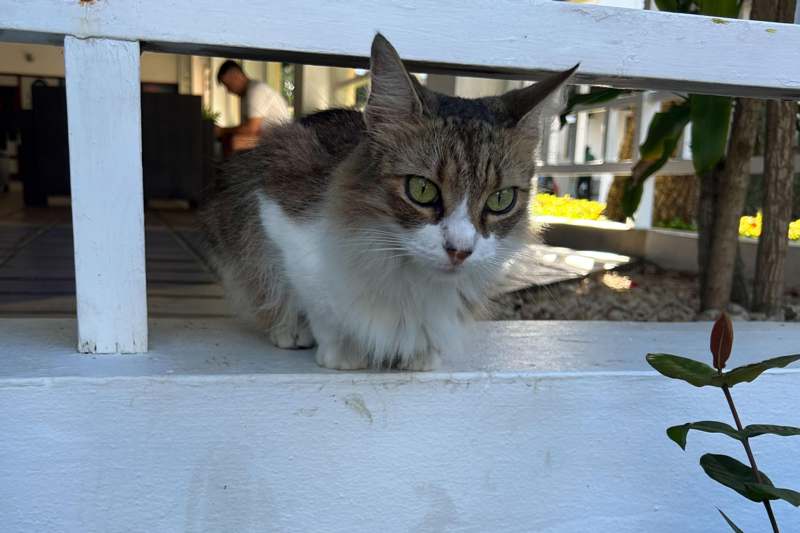
This is one of two cats that call the hotel property home.
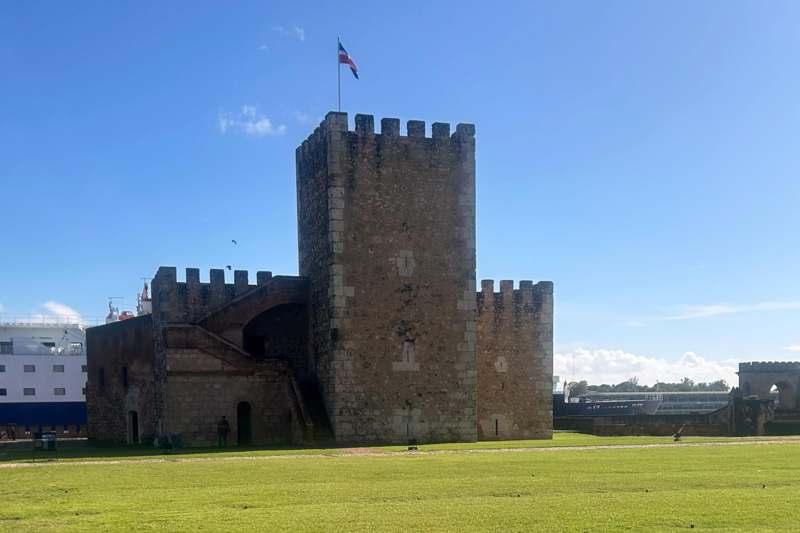
One last look at the Fortaleza Ozama.
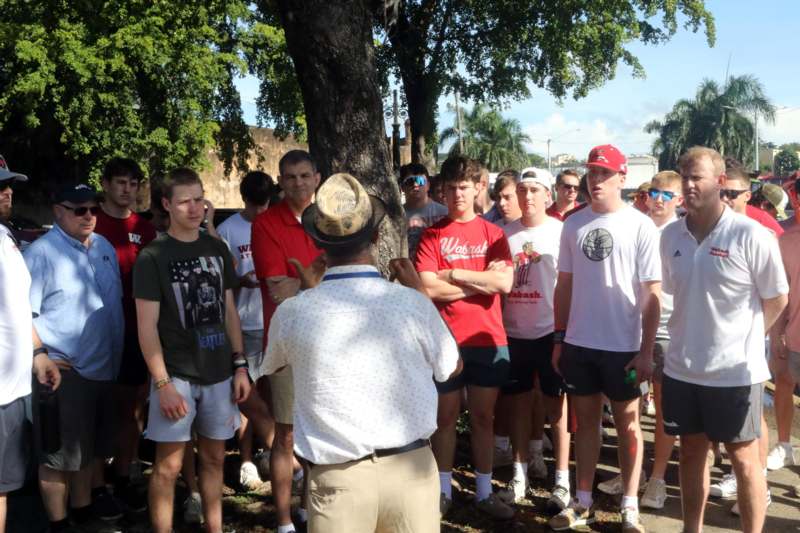
Dec. 19 was an off day for the Wabash baseball team in the Dominican Republic, but there was plenty of activity as the group immersed themselves in more than 500 years of history. The squad bused over to Santo Domingo for a morning tour of the Zona Colonial, the oldest portion of the Dominican Republic’s capital city, with history that dates back a half century. Juan Sanchez, a local tour guide (pictured above), started the adventure at the Fortaleza Ozama, the oldest fort in North America, which dates back to 1505, and down the Calle de las Damas.
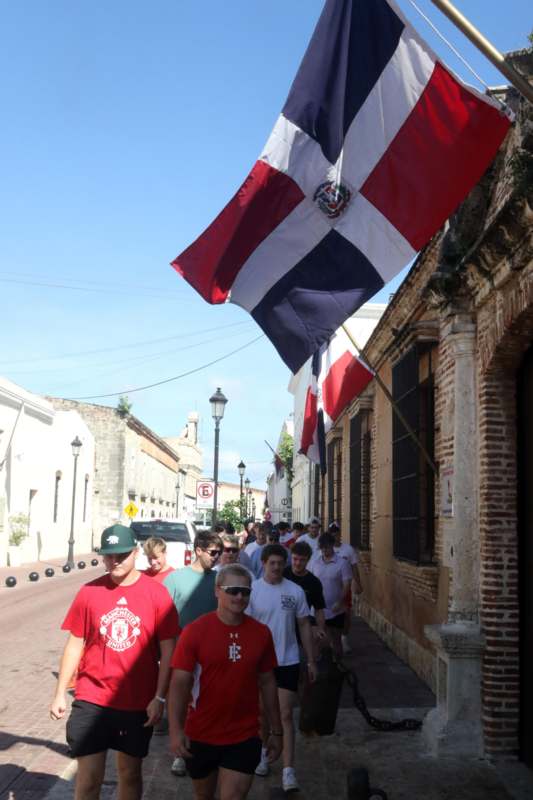
The team enters the Fortaleza Ozama.
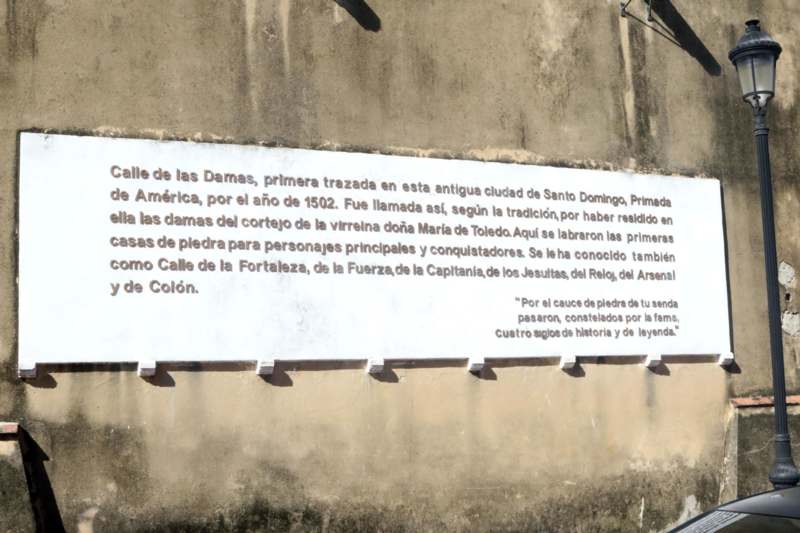
One of this hemisphere's most historic thoroughfares, Calle de las Damas was the through line of the morning's activities. This plaque reads: "Calle de las Damas, the first street laid out in this anciet city of Santo Domingo, the first city of America in 1502. According to tradition, it was named thus becasue the ladies of the viceroy's entourage, Dona Maria de Toledo, lived there. The first stone houses for important figures and conquerors were built here. It has been known as Calle de la Fortaleza, de la Fuerza, de la Capitania, de los Jusultas, del Reloj, del Arsenal, and Calle de Colon." In the lower right, it says, "Four centuries of history and legend passed along the stone bed of your path, marked by fame."
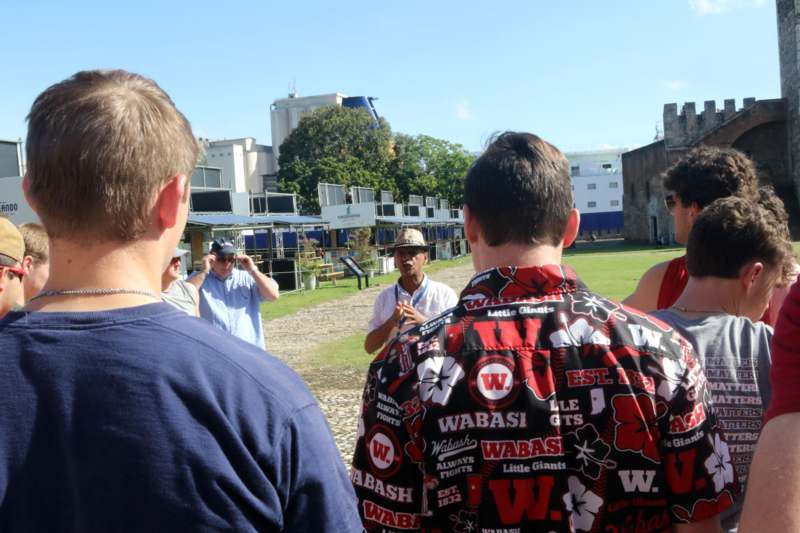
Sanchez quickly introduced the group to the history of the fort.
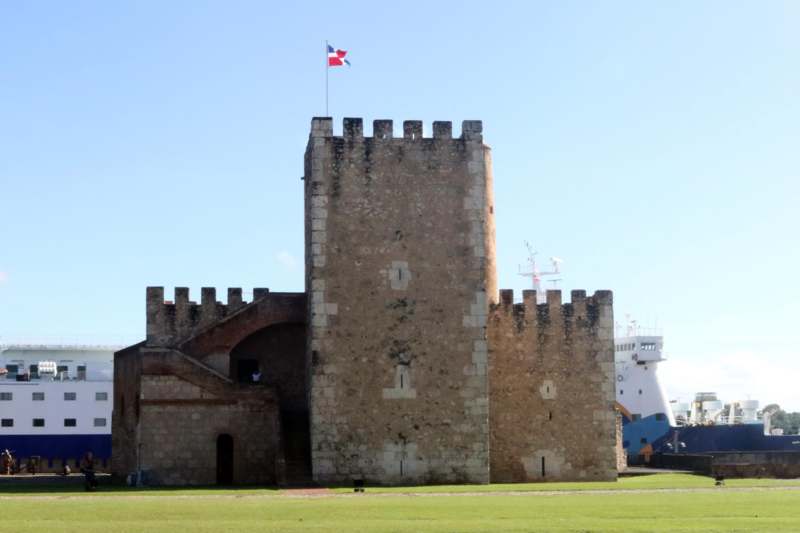
Fortaleza Ozama dates to 1505 and remains an imposing structure.
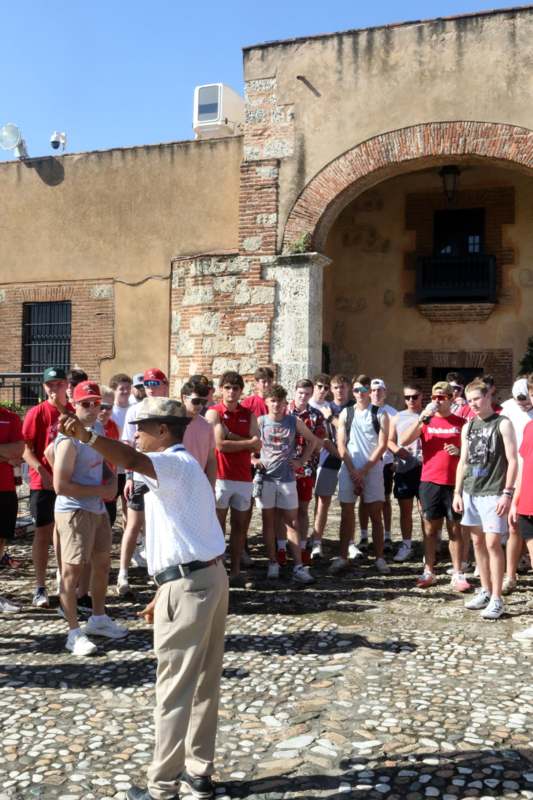
There were plenty of anecdotes that tied this strategic location to the history of North America.
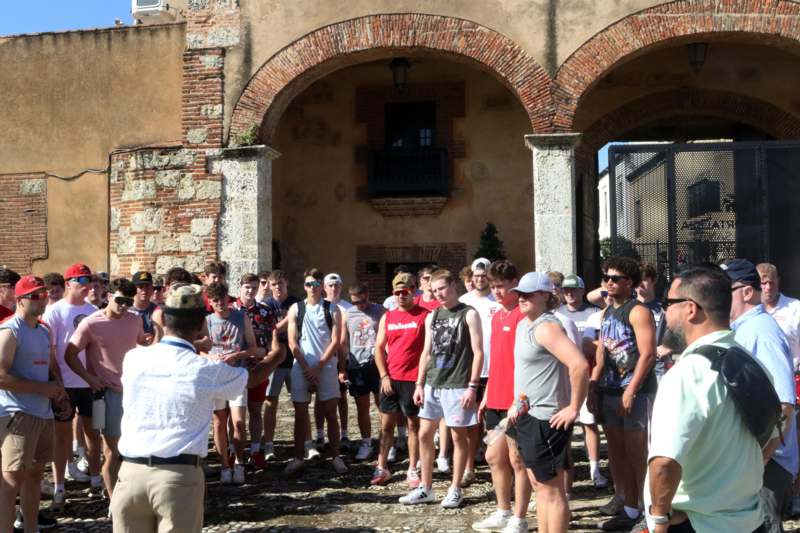
Sanchez was excellent at holding the group's attention.
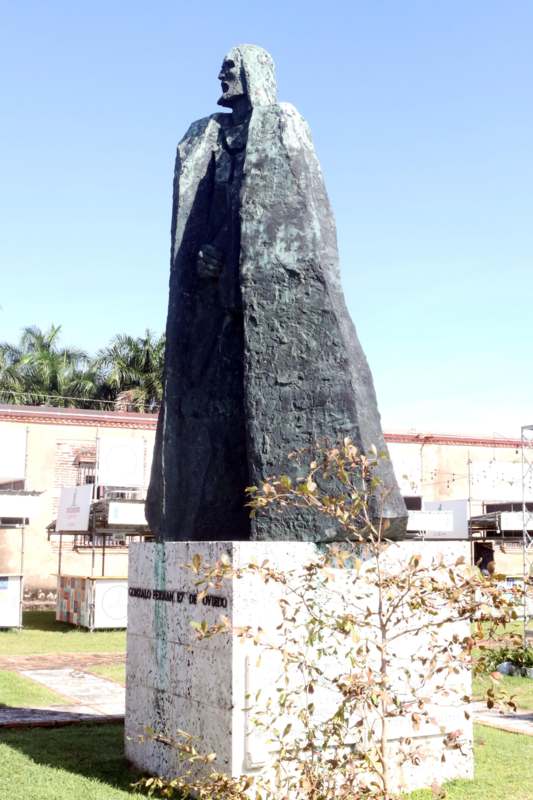
A statue of Gonzalo Fernandez de Oviedo, who oversaw the fortress from 1533-57 and served as an early historian of the area.
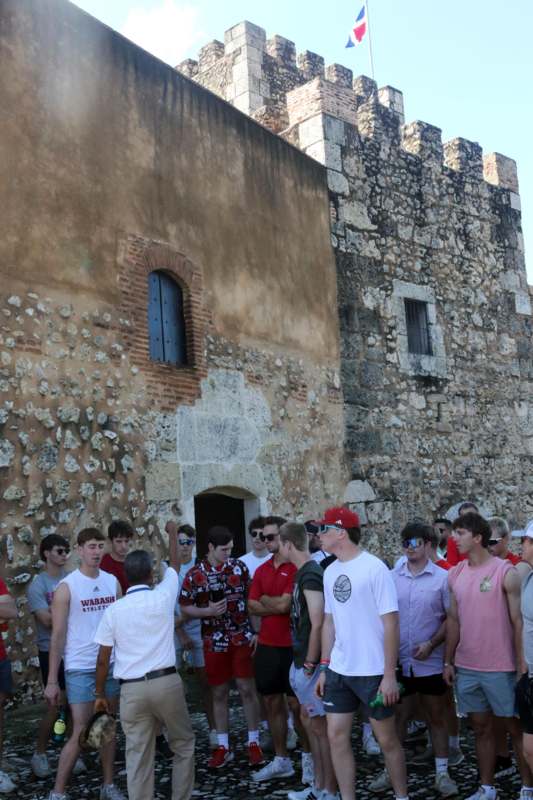
There were points of interest around every corner.
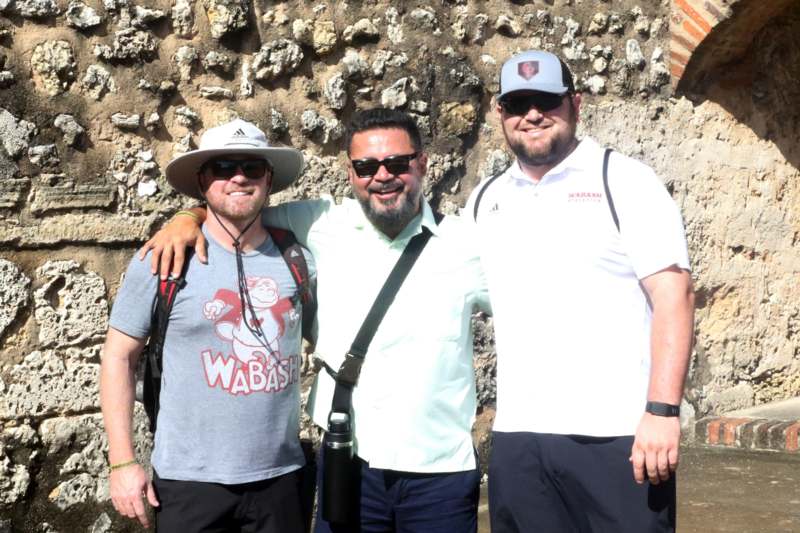
Coaches (from left) Jake Martin, Cesar Barrientos, and Caleb Fenimore.
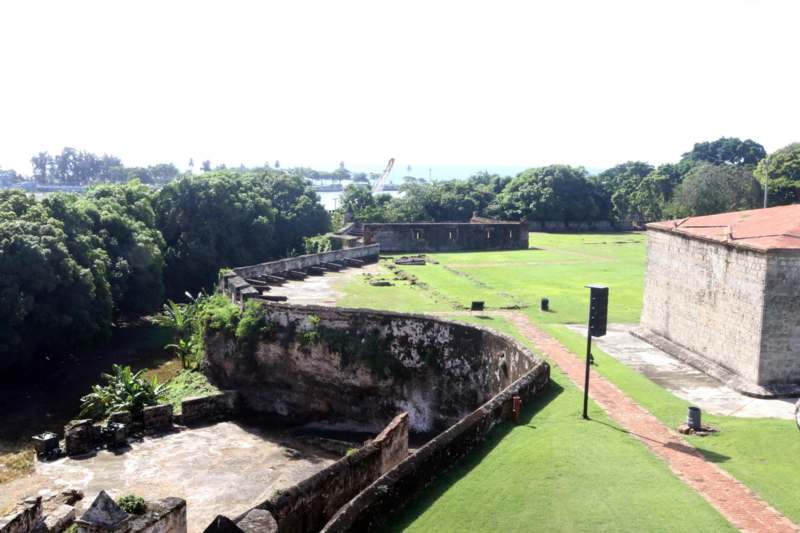
Five hundred years ago, there was a clear view of the harbor, but it's easy to see the frotress' strategic importance.
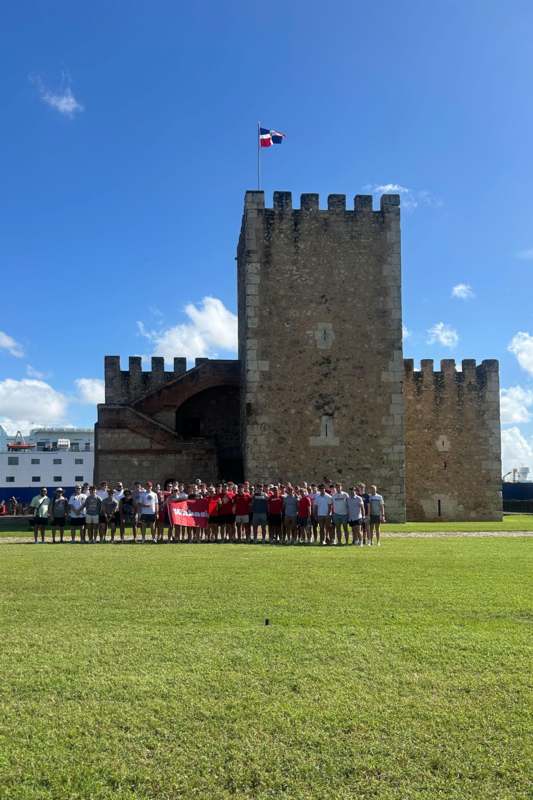
The LIttle Giants pause for a group photo.
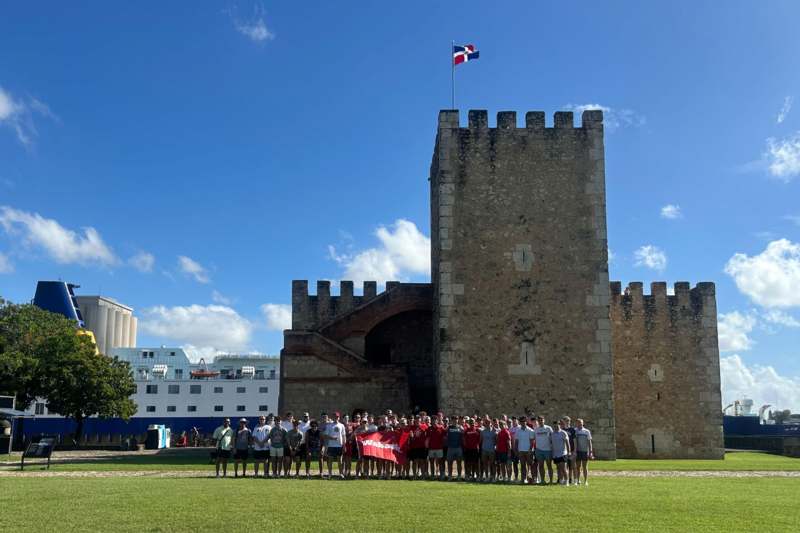
...and a horizontal from the same spot.
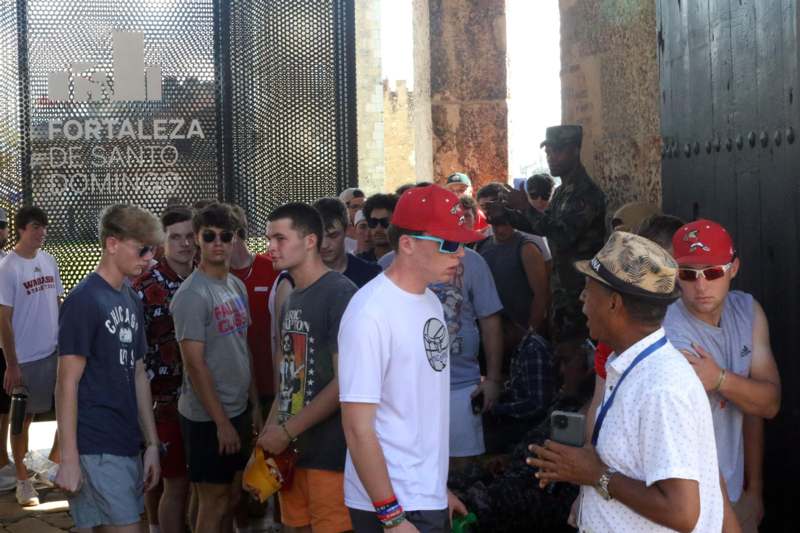
Sanchez was available for questions at any time, including this one by Rhys Anderson.
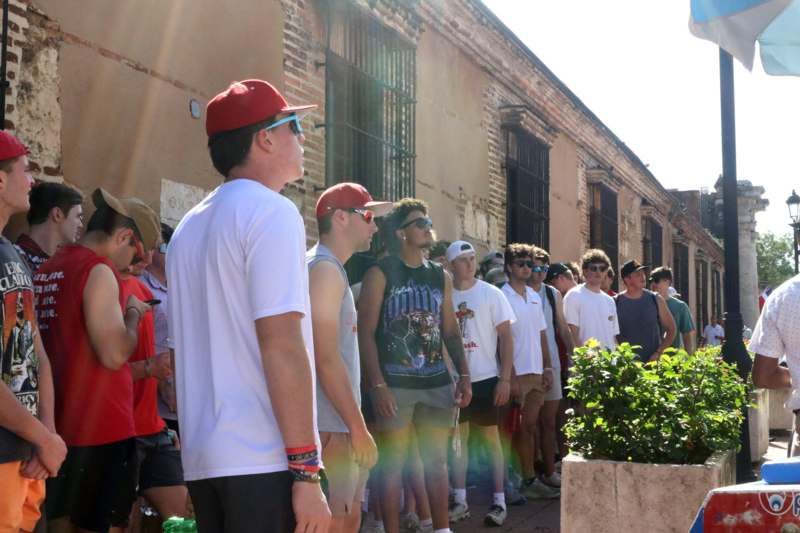
The team surveys Calle de las Damas.
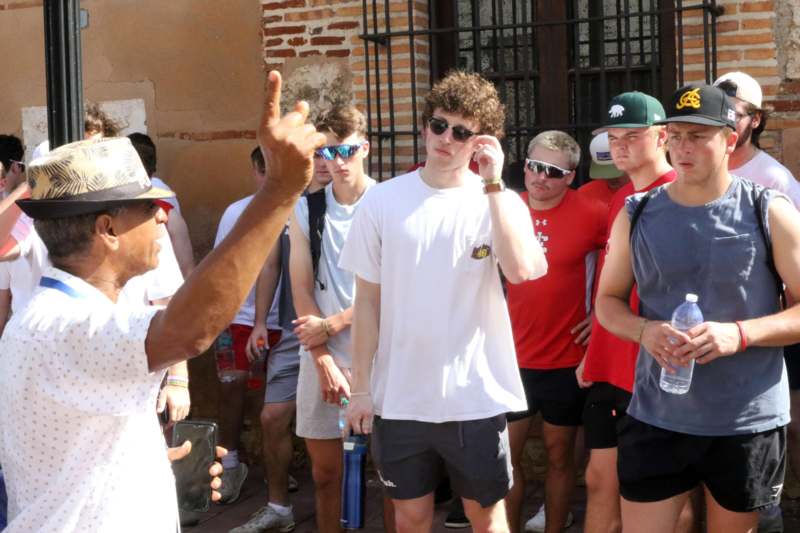
There is an engaging story on every block.
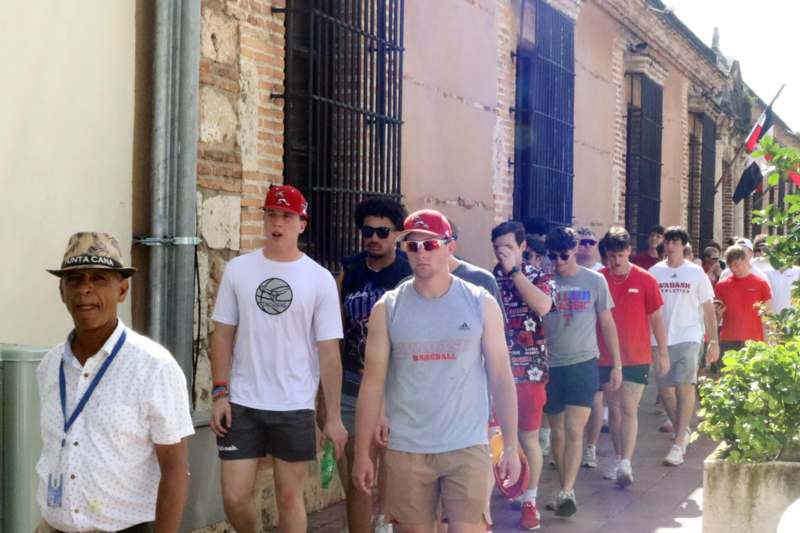
Sanchez was kind to keep the group on the shady side of the street.
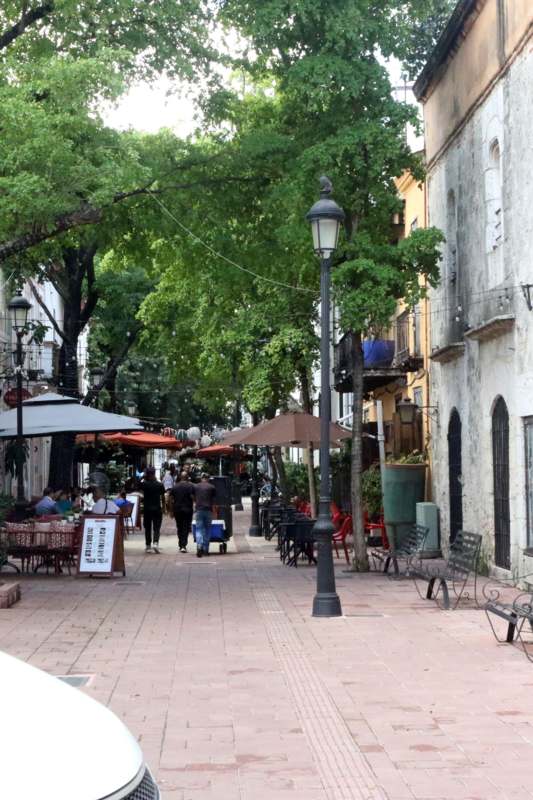
A view of an adjoining street.
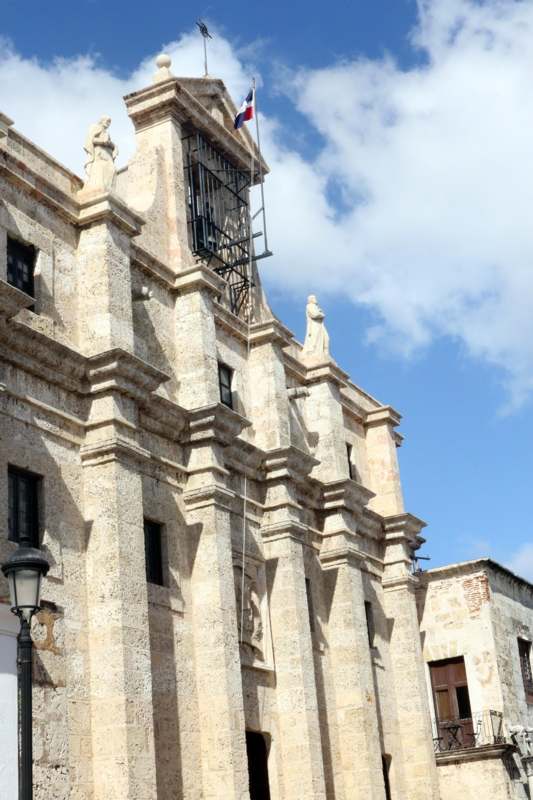
A look at the facade of the Panteon de la Patria, which is the final resting place for many of the key historical figures of the Dominican Republic.
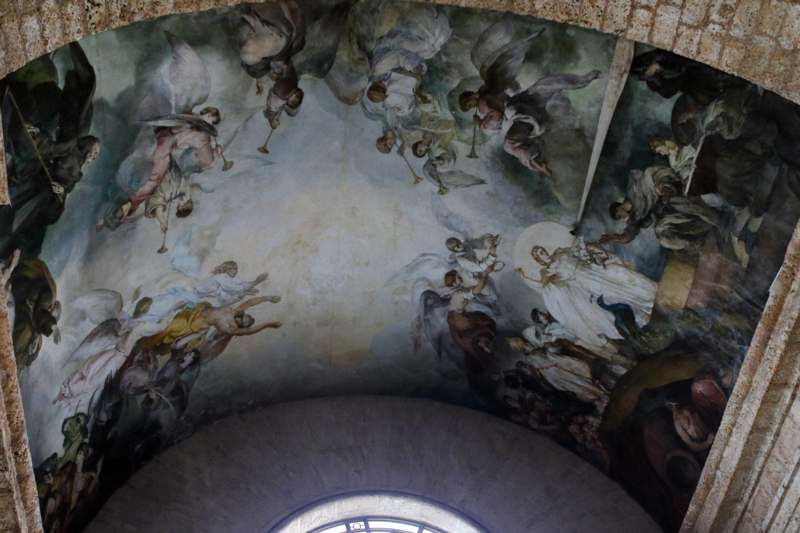
This mural can be found on the ceiling of the building.
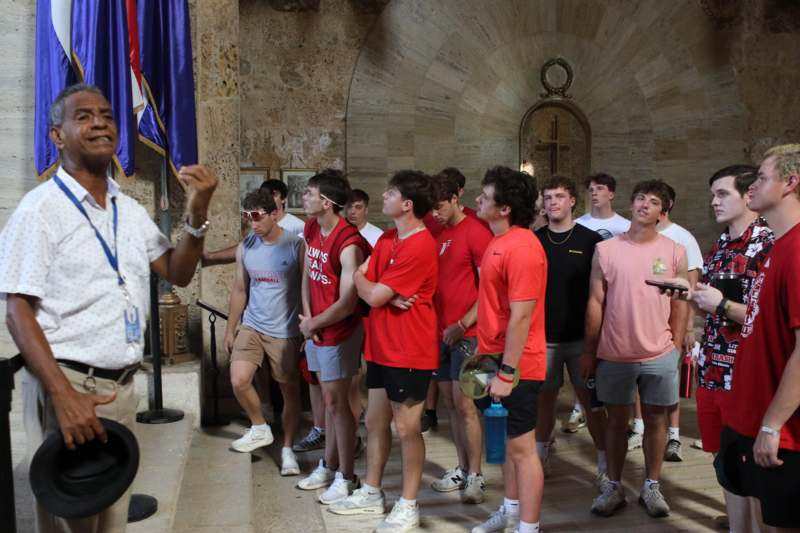
Sanchez unloaded a lot of history in this location.
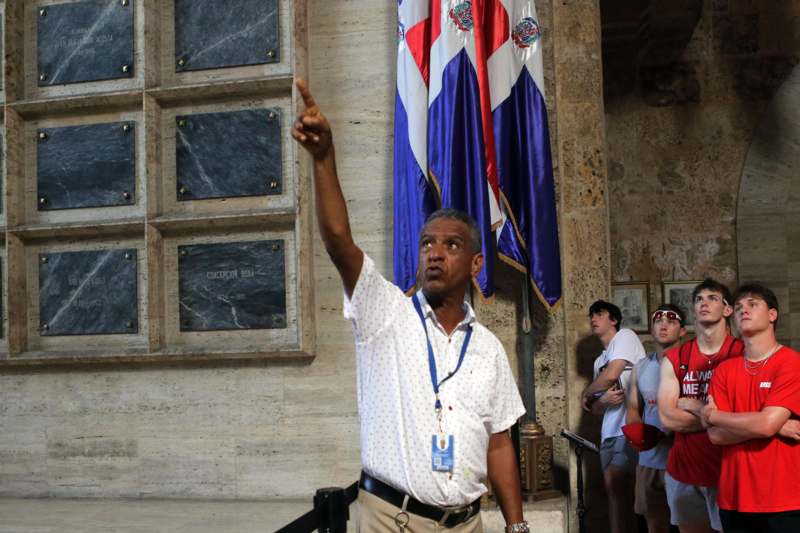
Sanchez points to the crypts of key historical figures.
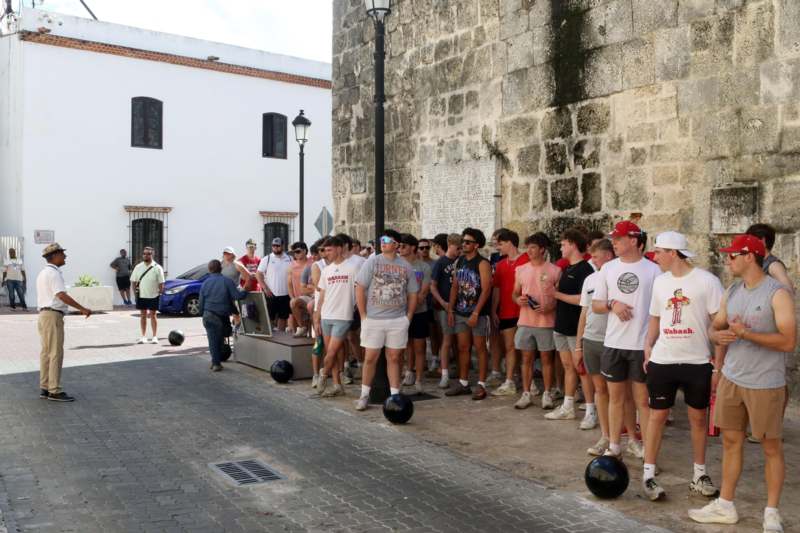
At this stop, Sanchez preps the group on some of the locations ahead.
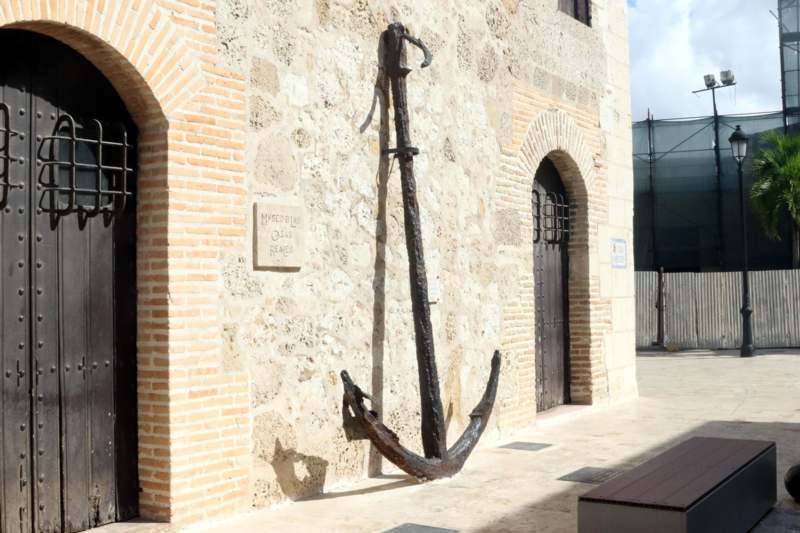
Nautical themes abound in this port city.
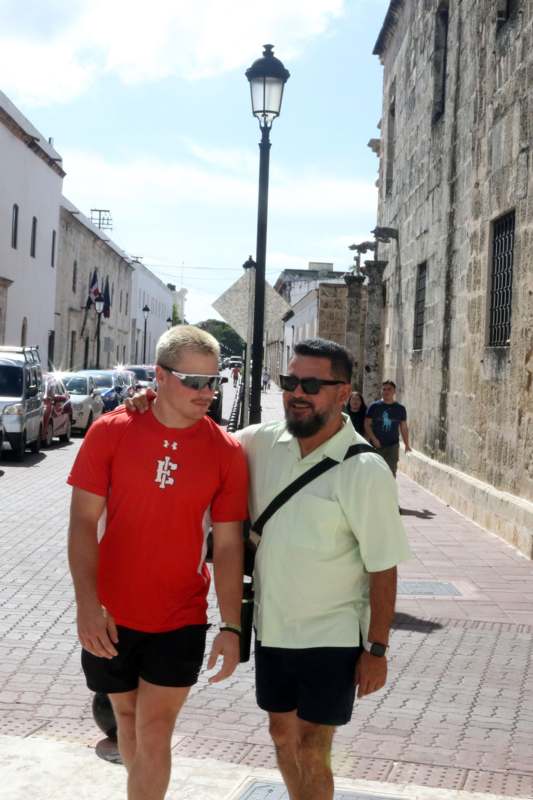
Barrientos (right) shares a light moment with Bradley Gilliam.
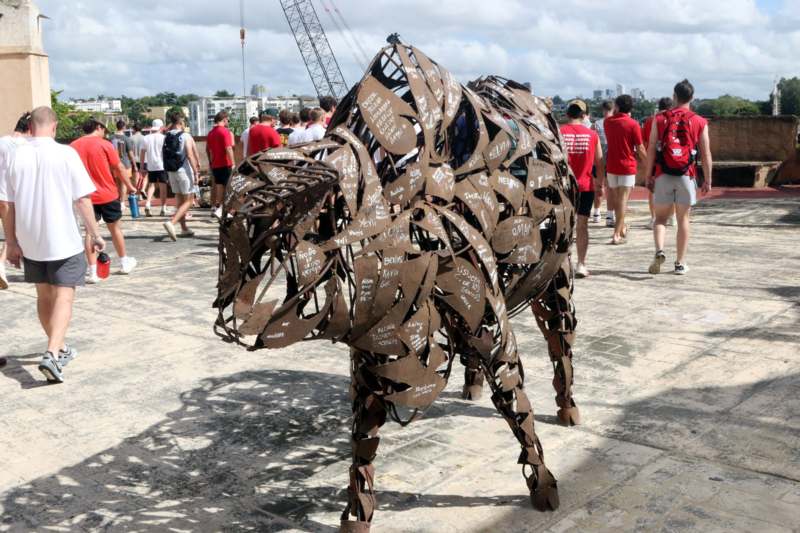
There was plenty of street art along the Calle de las Damas.
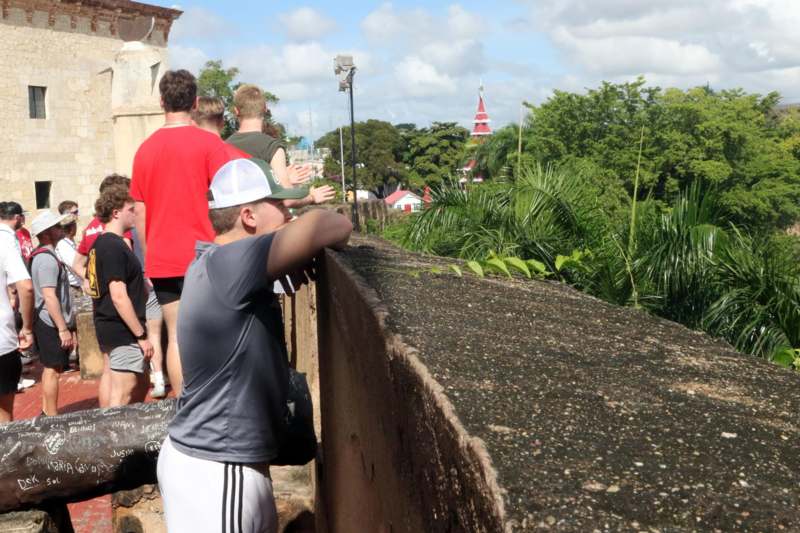
Jackson Wannemuehler looks into the distance.
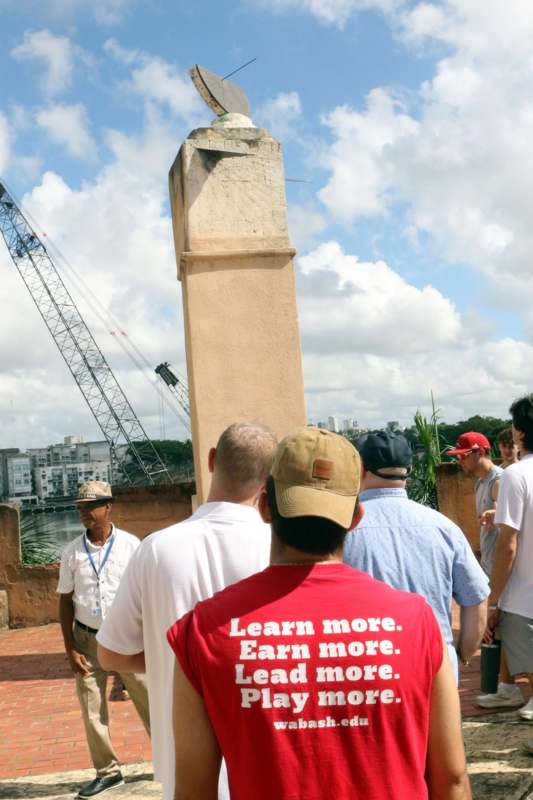
This sun dial still tells reliably good time even after nearly 400 years.

...and we're walking...
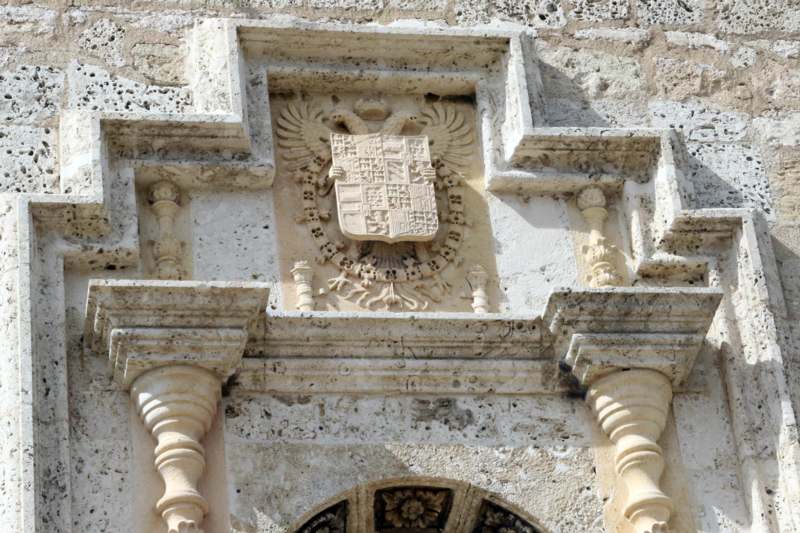
This unique crest at the Palacio de las Gobernadores, features both European and local influences.
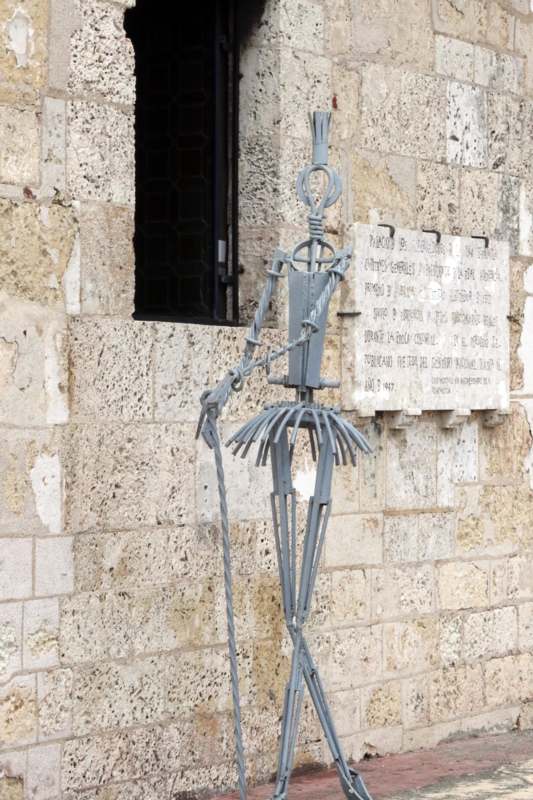
Beyond the public art, the plaque mentions that the Palacio was the first such building constructed in North America (circa 1512) and served as the royal residence during the colonial period. Further, it served as the seat of the national government until 1947.
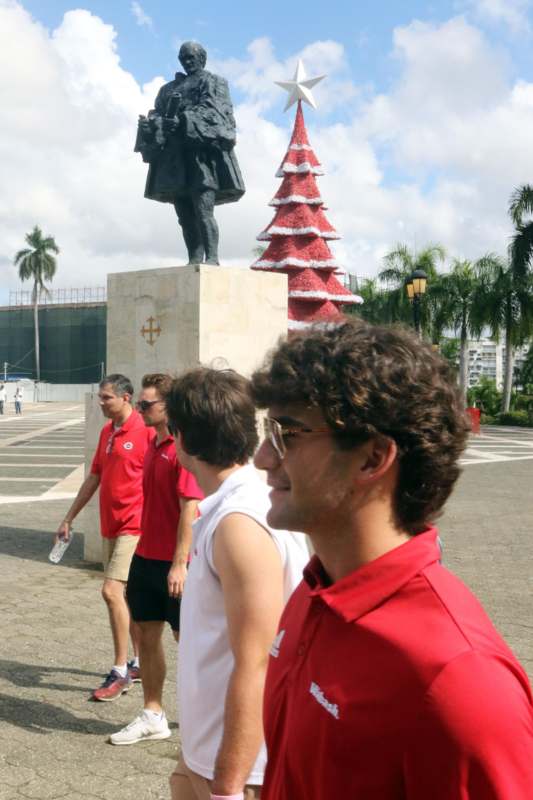
The Zona Colonial features many wide plazas.
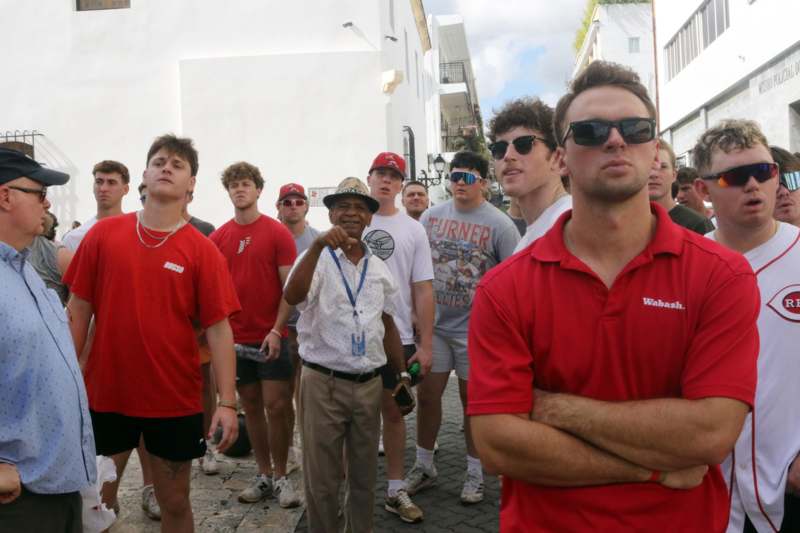
Sanchez tells wonderful stories.
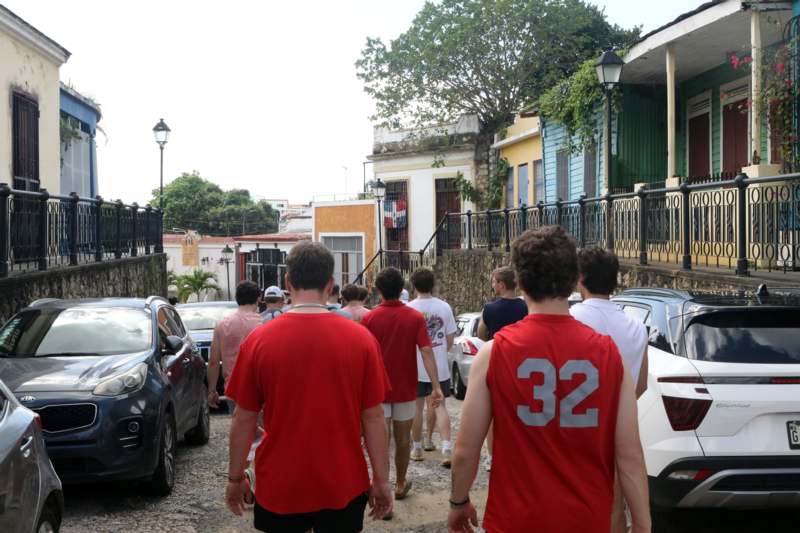
The group walks down a Dominican Republic street.
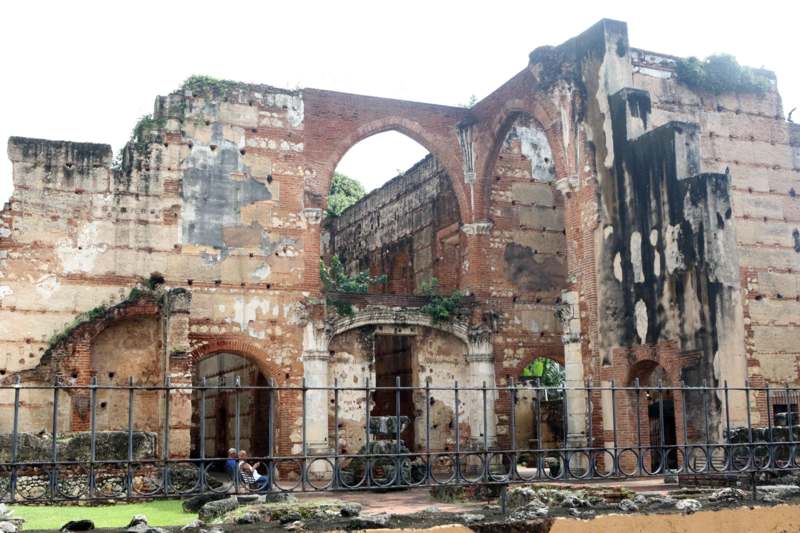
Hospital Saint Nicholas of Bari, North America’s first hospital.
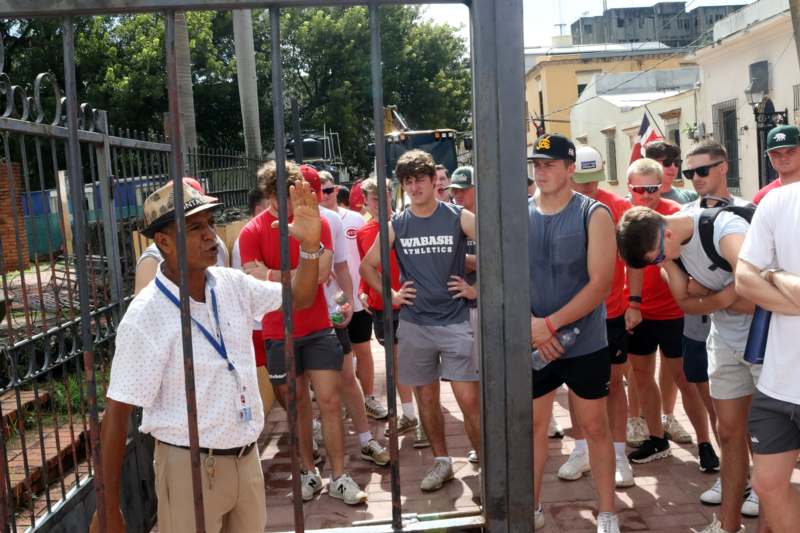
Sanchez makes a point at the Hospital Saint Nicholas of Bari.
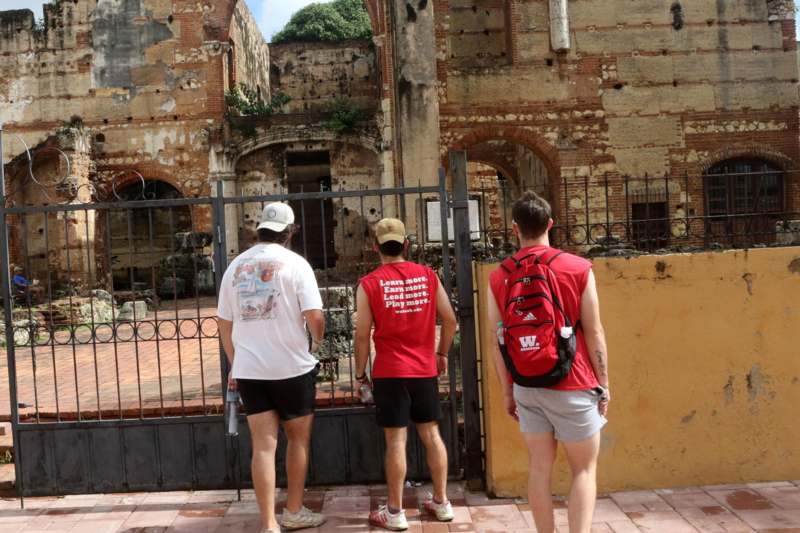
(from left) Robbie Manuzzi, Michael Galanos, and Braeden Bryant survey North America’s first hospital.
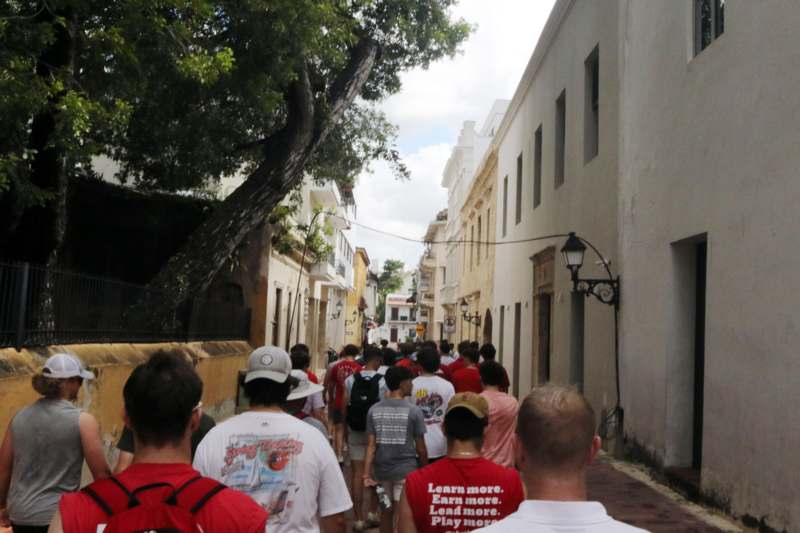
There are plenty of narrow and picturesque streets in the Zona Colonial.

Originally constructed between 1502-04, the Consistorial Palace is another historical monument in Santo Domingo, located on Calle el Conde.

The Little Giants arrive at Parque Colon, which honors Christopher Columbus.

Coach Martin pauses to read the inscription at the base of the Columbus statue. In the background, Nuestra Senora de la Encarnacion, the oldest church in North America, is visible.

A more complete look at Parque Colon and the Nuestra Senora de la Encarnacion.

Beyond the street musicians in Parque Colon, it's worth noting that the Nuestra Senora de la Encarnacion was the site of Columbus’ final resting place until 1992.

The afternoon saw the group head to a sugar mill in San Gregorio de Nigua that dates back to the early 1600s. The last few steps included these grazing neighbors.

This sugar mill is a well preserved example of early North American sugar cane processing operations.

Many of the buildings in the complex are standing and largely intact.

The visit to the sugar mill brought many of the students back to specific topics from their SPA 312/HSP277 course, The Dominican Republic and Baseball, this fall.

Rogers (right in blue hat) addresses the students and begins an educational discussion on site.

As Rogers said, “It's one thing to learn it in the classroom, to be interested and even excited about something in the classroom, but when you're here, when you're actually in the place that you’re studying, the connections become much more complex and filled out. Students retain them in ways they wouldn’t if they just had the class or just took a trip.”

Jackson Woehr (rear center, in red shirt), was one of the students who took the trip. He made a brief presentation and facilitated a discussion about the location's history and the economic impacts.

Prof. Rogers used baseball as a hook to get students to think about issues of colonialism through the Spanish colonial legacy in the Caribbean and Latin America, as well as the U.S. legacy of involvement and imperialism.

As the class learned, and shared that information with the rest of the team, sugar was king in the Caribbean in the 16 and 1700s, creating an economic engine that created wealth on the island for both Haiti, ruled by the French, and the Dominican Republic ruled by Spain. Exports like molasses and rum brought untold riches to both crowns.

Matthew Manzuk (left) and Jacob Edwards take in the grounds.

Here, Rogers (center) answers a question as Martin surveys in the background (left).

Immersion trips give professors time to explain the nuance of a subject on site.

Sugar cane was processed. On the upper level, the stalks were laid out on a huge circular stone platform with a slight slope. Large stones were rolled over the stalks pressing out the sucrose, where it was collected on the lower level, where (from left) Matthew Wright, Matthew Manzuk, and Tanner Turnpaugh assess the stonework.

This site was also the location of the first slave uprising in the New World on Dec. 25, 1521. This mural tells that story.

The rebellion occurred at night along the Nigua River and was eventually put down by the colonial militia.

The uprising led to new slave laws, which were issued by the colonial government of Hispaniola in January 1522.

Many of the buildings feature intricate stone work of which the bricks were made on location.

Rogers makes a point to a large group of students.

This was a great learning experience for all involved.

The students had plenty of questions and Rogers answered them all. Pictured here are (from left) Trey Pitcock, Miles Williams, Rhys Anderson, Prof. Rogers, and Jarrod Kirsch.

Williams (left) and Martin talk on a balcony overlook.

(from left) Connor Lambert, Evan Neukam, McConnell, Coby Stephens, and Henry Birk contemplate the mill's history.

San Gregorio de Nigua provides plenty of information to assess and immerse.

A photo of some of what remains on the property.

This is the main building of the complex with a still complete chimney.

A view from the beach of the team's hotel in Boca Chica.

This beach dog enjoyed the morning sun.

The palm trees provided much-appreciated shade.

Boats anchored near by.

These boats provide plenty of activity on the water.

The sunrise on Dec. 19.

This swing could be a nice beach diversion.

This is one of two cats that call the hotel property home.

One last look at the Fortaleza Ozama.

Dec. 19 was an off day for the Wabash baseball team in the Dominican Republic, but there was plenty of activity as the group immersed themselves in more than 500 years of history. The squad bused over to Santo Domingo for a morning tour of the Zona Colonial, the oldest portion of the Dominican Republic’s capital city, with history that dates back a half century. Juan Sanchez, a local tour guide (pictured above), started the adventure at the Fortaleza Ozama, the oldest fort in North America, which dates back to 1505, and down the Calle de las Damas.

The team enters the Fortaleza Ozama.

One of this hemisphere's most historic thoroughfares, Calle de las Damas was the through line of the morning's activities. This plaque reads: "Calle de las Damas, the first street laid out in this anciet city of Santo Domingo, the first city of America in 1502. According to tradition, it was named thus becasue the ladies of the viceroy's entourage, Dona Maria de Toledo, lived there. The first stone houses for important figures and conquerors were built here. It has been known as Calle de la Fortaleza, de la Fuerza, de la Capitania, de los Jusultas, del Reloj, del Arsenal, and Calle de Colon." In the lower right, it says, "Four centuries of history and legend passed along the stone bed of your path, marked by fame."

Sanchez quickly introduced the group to the history of the fort.

Fortaleza Ozama dates to 1505 and remains an imposing structure.

There were plenty of anecdotes that tied this strategic location to the history of North America.

Sanchez was excellent at holding the group's attention.

A statue of Gonzalo Fernandez de Oviedo, who oversaw the fortress from 1533-57 and served as an early historian of the area.

There were points of interest around every corner.

Coaches (from left) Jake Martin, Cesar Barrientos, and Caleb Fenimore.

Five hundred years ago, there was a clear view of the harbor, but it's easy to see the frotress' strategic importance.

The LIttle Giants pause for a group photo.

...and a horizontal from the same spot.

Sanchez was available for questions at any time, including this one by Rhys Anderson.

The team surveys Calle de las Damas.

There is an engaging story on every block.

Sanchez was kind to keep the group on the shady side of the street.

A view of an adjoining street.

A look at the facade of the Panteon de la Patria, which is the final resting place for many of the key historical figures of the Dominican Republic.

This mural can be found on the ceiling of the building.

Sanchez unloaded a lot of history in this location.

Sanchez points to the crypts of key historical figures.

At this stop, Sanchez preps the group on some of the locations ahead.

Nautical themes abound in this port city.

Barrientos (right) shares a light moment with Bradley Gilliam.

There was plenty of street art along the Calle de las Damas.

Jackson Wannemuehler looks into the distance.

This sun dial still tells reliably good time even after nearly 400 years.

...and we're walking...

This unique crest at the Palacio de las Gobernadores, features both European and local influences.

Beyond the public art, the plaque mentions that the Palacio was the first such building constructed in North America (circa 1512) and served as the royal residence during the colonial period. Further, it served as the seat of the national government until 1947.

The Zona Colonial features many wide plazas.

Sanchez tells wonderful stories.

The group walks down a Dominican Republic street.

Hospital Saint Nicholas of Bari, North America’s first hospital.

Sanchez makes a point at the Hospital Saint Nicholas of Bari.

(from left) Robbie Manuzzi, Michael Galanos, and Braeden Bryant survey North America’s first hospital.

There are plenty of narrow and picturesque streets in the Zona Colonial.

Originally constructed between 1502-04, the Consistorial Palace is another historical monument in Santo Domingo, located on Calle el Conde.
SANTO DOMINGO, Dominican Republic – Wednesday was an off day for the Wabash College baseball team, but there was plenty of activity as the group immersed themselves in more than 500 years of history.
About one-third of the team participated in a class this fall led by Spanish Professor Dan Rogers, SPA 312/HSP277: The Dominican Republic and Baseball, and came ready with a knowledge of the history of the island that dates back to Christopher Columbus’ landing in 1492 and colonialization under the occupations that included the Spanish, French, Haitians, and the U.S.
“It was interesting to see how we can relate our academics at Wabash to pretty much anywhere in the world,” said Jackson Woehr ’26 from Whitestown, Indiana. “We we were able to apply what we learned in class and basically inform our teammates who didn't take the class about this history.”
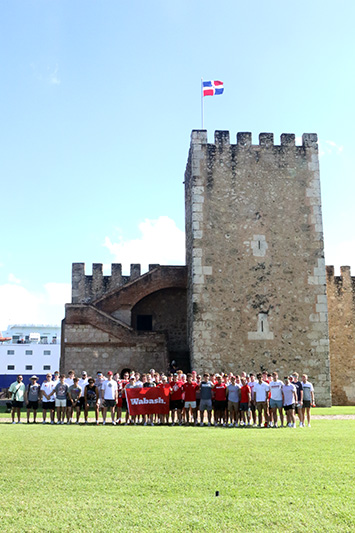
Sanchez led the group to stops that included the Panteon de la Patria, an 18th century church that now honors esteemed members of the Dominican Republic’s past. From there, stops included the Palacio de las Gobernadores, Hospital Saint Nicholas of Bari, North America’s first hospital, and ended in Parque Colon, which featured a statue of Columbus and the Nuestra Senora de la Encarnacion, the oldest church in North America and the site of Columbus’ final resting place until 1992.
“Getting to Santo Domingo and to see where Columbus had come and colonized was interesting,” said Braeden Bryant ’25 from Kokomo, Indiana. “It’s crazy to think that the fort and so many other buildings are standing to this day, and that the port is still in use brings so much of what we learned to life.”
The afternoon included a visit to a sugar mill in San Gregorio de Nigua that dates back to the early 1600s, which brought the students back to specific course topics. Prof. Rogers used baseball as a hook to get students to think about issues of colonialism through the Spanish colonial legacy in the Caribbean and Latin America, as well as the U.S. legacy of involvement and imperialism.
“It's one thing to learn it in the classroom, to be interested and even excited about something in the classroom, but when you're here, when you're actually in the place that you’re studying, the connections become much more complex and filled out. Students retain them in ways they wouldn’t if they just had the class or just took a trip.”
As the class learned, sugar was king in the Caribbean in the 16 and 1700s, creating an economic engine that created wealth on the island for both Haiti, ruled by the French, and the Dominican Republic ruled by Spain. Exports like molasses and rum brought untold riches to both crowns.
The sugar mill at San Gregorio tuned out to be a magnificent site for study, allowing Woehr to present material learned in class directly to teammates steps from the main processing area of the mill.
“I felt like I was like teaching my teammates valuable information about the culture and history of the Dominican 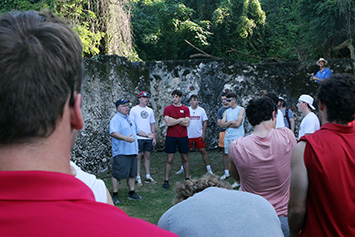
The students learned through the class that without sugar there would be no baseball, as many of the professional teams in the D.R. were originally funded by the industry. Founded in the early 1900s, D.R. baseball remains strong, as more than 100 active Major League Baseball players come from the island nation.
Grant Stratton ’25 feels the class prepared him for the games the Little Giants will play here because of his understanding of the history.
“I’ve seen a mutual respect between us and the teams that we’re playing,” said the Jasper, Indiana product. “I didn’t expect the kind of respect that we've been given here, and that was going to be given both ways. That's been special for me.”
Bryant agreed, “We may not speak the same language, but we play the same game and through that, we build relationships. It’s been great to experience.”
